
- Weill Cornell Medicine


Slips, Trips, and Falls: Understanding, Preventing, and Mitigating Risks
By Gian Joseph, Safety Advisor
As we enter the rainy and cold season, we face several risks , which include slips , trips, and fall s in our day-to-day activities. It is important t o be aware of hazards around us and learn how to properly identify and assess any risks with each step.
Slips, trips, and falls (STFs) are common accidents that can lead to severe injuries. These incidents occur in various settings, from homes and workplaces to public spaces , and i t is essential to understand the causes, consequences, and , most importantly, strategies for prevention and mitigation.
1. Understanding the Dynamics of STFs. STFs are caused by the following .
Insu fficient friction between the shoe and the walking surface. Common causes include wet or greasy floors, spills, and loose debris (Slip and Fall Accidents, 2021).
When a person's foot collides with an object or an uneven surface, it caus es them to lose balance. Typical trip hazards include cluttered walkways, electrical cords, uneven flooring, and damaged or upturned mats (Slip and Fall Accidents, 2021).
2. The Impact of STFs
Slips, trips, and falls have far-reaching effects, affecting individuals and society . Personal i njuries range from minor cuts , bruises, sprains , and abrasions to fractures, dislocations, and head injuries (National Safety Council, 2021). The medical expenses associated with treating STF-related injuries can be substantial , including hospital stays, surgeries, rehabilitation, and ongoing care (National Safety Council, 2021). STFs can result in missed workdays and reduced productivity for both individuals and employers. Workers' compensation claims and absenteeism contribute to economic costs (National Safety Council, 2021). Lastly, t he physical and psychological consequences of STFs can limit mobility, independence, and overall quality of life, especially among older adults ( Sahyoun et al., 2020).
3. Prevention and Mitigation Strategies
Preventing and mitigating STFs involves a combination of awareness, environmental modifications, and education . H ere are some ways you can take precaution s against STFs in your daily activities;
Clear Pathways: Maintain clear, unobstructed walkways by removing clutter and tripping hazards such as cords, toys, and loose rugs (Occupational Safety and Health Administration [OSHA], 2002).
Adequate Lighting: Ensure proper lighting in all areas, both indoors and outdoors, to improve visibility and reduce the risk of tripping over obstacles (OSHA, 2002).
Slip-Resistant Flooring: Install slip-resistant flooring materials, especially in areas prone to moisture, like bathrooms and kitchens (OSHA, 2002).
Footwear: Encourage the use of proper footwear with good traction, especially in environments where slip hazards are prevalent ( Sahyoun et al., 2020).
Handrails and Guardrails: Install and maintain handrails and guardrails on stairs, ramps, and elevated platforms to provide support and prevent falls (OSHA, 2002).
Warning Signs: Use signage to alert individuals to potential hazards, such as wet floors or uneven surfaces (OSHA, 2002).
Education and Training: Promote awareness and provide training to individuals on recognizing and avoiding STF hazards (National Institute for Occupational Safety and Health [NIOSH], 2015).
Workplace Safety: Employers should implement safety protocols and conduct risk assessments in the workplace, addressing potential STF risks (NIOSH, 2015).
Regular Maintenance: Routinely inspect and maintain buildings, walkways, and outdoor areas to identify and address potential hazards promptly (NIOSH, 2015).
4. A Holistic Approach to STF Prevention
Preventing and mitigating STFs require a collaborative approach involving individuals, organizations, and communities:
Individuals : Exercise caution when walking, especially in unfamiliar or potentially hazardous environments. Wear appropriate footwear and take your time, especially in wet or slippery conditions ( Sahyoun et al., 2020).
Employers: Create a safe work environment by identifying and mitigating STF risks. Provide training to employees on safety protocols and the proper use of equipment (OSHA, 2002).
Property Owners and Managers: Ensure properties are well-maintained and free from hazards. Regularly inspect and address issues promptly (NIOSH, 2015).
Government and Local Authorities: Enforce building codes and regulations that promote safety, especially in public spaces and commercial buildings (OSHA, 2002).
Conclusion
Slips, trips, and falls are preventable accidents that carry substantial personal, economic, and societal costs. By comprehending the causes, consequences, and prevention strategies, we can significantly reduce the incidence of STFs and mitigate their impact. Whether at home, at work, or in public spaces, prioritizing safety and fostering awareness about STFs is crucial for the well-being of individuals and communities. Let us strive collectively to create environments where everyone can move safely and confidently, free from the fear of falling.
References:
National Institute for Occupational Safety and Health (NIOSH). (2015). Preventing Slips, Trips, and Falls in Wholesale and Retail Trade Establishments. https://www.cdc.gov/niosh/docs/2015-100/pdfs/2015-100.pdf
National Safety Council. (2021). Injury Facts. https://injuryfacts.nsc.org/work/overview/work-safety-introduction/work-...
Occupational Safety and Health Administration (OSHA). (2002). OSHA Publication 3151-12R. Preventing Slips, Trips, and Falls in Wholesale and Retail Trade Establishments. https://www.osha.gov/Publications/osha3151.pdf
Sahyoun , N. R., Pratt, L. A., & Lentzner , H. (2020). The Changing Profile of Nursing Home Residents: 1985-1997. Journal of Aging and Health, 12(3), 336-363.
Slip and Fall Accidents. (2021). InjuryClaimCoach.com. https://www.injuryclaimcoach.com/slip-and-fall-accidents.html
Please note that the sources cited are accurate as of the time of writing this article. For the most current information, consult authoritative sources and local health authorities.
Go to the staff directory for individual contacts within EHS. You may also use the Weill Cornell Medicine online directory to search for faculty and staff.
Create an EHS Incident
Weill Cornell Medicine Environmental Health and Safety 402 East 67th Street Room LA-0020 New York, NY 10065 Phone: (646) 962-7233 Fax: (646) 962-0288
- Skip to main content
- Skip to site information
- Departments
Language selection
- Français

Scheduled maintenance - Thursday, July 12 at 5:00 PM EDT
We expect this update to take about an hour. Access to this website will be unavailable during this time.
Prevention of Slips, Trips and Falls
On this page, how do falls happen, how to prevent falls due to slips and trips, what can you do to avoid falling at work.
Statistics show that the majority (67%) of falls happen on the same level resulting from slips and trips. The remaining 30% are falls from a height. This document will summarize information on "falls on the same level" (slips and trips). Falls from an elevation, such as falls from ladders, roofs, down stairs or from jumping to a lower level, etc., is discussed in other documents since each type of fall must be assessed as part of a fall prevention program .
Slips happen where there is too little friction or traction between the footwear and the walking surface. Common causes of slips are:
- wet or oily surfaces
- occasional spills
- weather hazards
- loose, unanchored rugs or mats
- flooring or other walking surfaces that do not have the same degree of traction in all areas
Trips happen when your foot collides (strikes, hits) an object causing you to lose balance and, eventually fall. Common causes of tripping are:
- obstructed view
- poor lighting
- clutter in your way
- wrinkled carpeting
- uncovered cables
- bottom drawers not being closed
- uneven (steps, thresholds) walking surfaces
Both slips and trips result from unintended or unexpected change in the contact between the feet and the ground or walking surface. This fact shows that good housekeeping, quality of walking surfaces (flooring), selection of proper footwear, and appropriate pace of walking are critical for preventing fall incidents.
Housekeeping
Good housekeeping is the first and the most important (fundamental) level of preventing falls due to slips and trips. It includes:
- cleaning all spills immediately
- marking spills and wet areas
- mopping or sweeping debris from floors
- removing obstacles from walkways and always keeping walkways free of clutter
- securing (tacking, taping, etc.) mats, rugs and carpets that do not lay flat
- always closing file cabinet or storage drawers
- covering cables that cross walkways
- keeping working areas and walkways well lit
- replacing used light bulbs and faulty switches
Without good housekeeping practices, any other preventive measures such as installation of sophisticated flooring, specialty footwear or training on techniques of walking and safe falling will never be fully effective.
For more information about effective housekeeping, visit the OSH Answers document on Workplace Housekeeping - Basic Guide .
Changing or modifying walking surfaces is the next level of preventing slip and trips. Recoating or replacing floors, installing mats, pressure-sensitive abrasive strips or abrasive-filled paint-on coating and metal or synthetic decking can further improve safety and reduce the risk of falling. However, it is critical to remember that high-tech flooring requires good housekeeping as much as any other flooring. In addition, resilient, non-slippery flooring prevents or reduces foot fatigue and contributes to slip-prevention measures.
In workplaces where floors may be oily or wet or where workers spend considerable time outdoors, prevention of fall incidents should focus on selecting proper footwear. Since there is no footwear with anti-slip properties for every condition, consultation with manufacturers is highly recommended.
Properly fitting footwear increases comfort and prevents fatigue which, in turn, improves safety for the employee. For more information on footwear visit the OSH Answers document on Safety Footwear .
You can reduce the risk of slipping on wet flooring by:
- taking your time and paying attention to where you are going
- adjusting your stride to a pace that is suitable for the walking surface and the tasks you are doing
- walking with the feet pointed slightly outward
- making wide turns at corners
You can reduce the risk of tripping by:
- keeping walking areas clear from clutter or obstructions
- keeping flooring in good condition
- always using installed light sources that provide sufficient light for your tasks
- using a flashlight if you enter a dark room where there is no light
- making sure that things you are carrying or pushing do not prevent you from seeing any obstructions, spills, etc.
- Fact sheet last revised: 2023-03-28

Slips, Trips, And Falls Hazards | How To Prevent Them
Every year, countless individuals experience the unexpected mishap of a slip, trip, or fall. These incidents occur across all age groups and settings, from homes and public spaces to workplaces. While often brushed off as minor inconveniences or embarrassments, slips, trips, and falls can lead to serious injuries and significant financial and emotional costs.
The key to tackling this pervasive issue lies in understanding the factors contributing to these accidents and implementing effective prevention measures. In this blog, we delve into the causes of slips, trips, and falls, their impact, and, most importantly, how we can prevent them.
By understanding these risks, we empower ourselves to create safer environments, whether looking at the comfort of our homes, the safety of public spaces, or the well-being of employees in a workplace. This guide aims to heighten awareness, encourage preventive action, and highlight our shared responsibility in reducing the risks and consequences of slips, trips, and falls. Join us as we navigate through this important topic step by carefully step.
The Importance of Preventing Slips, Trips, and Falls
The impact of slips, trips, and falls can be highly significant, from bruised shins to broken bones. These incidents aren’t just about physical injury. The repercussions can ripple outwards, affecting an individual’s quality of life, workability, and mental well-being. In the workplace, such accidents can lead to significant downtime, loss of productivity, and even legal implications for businesses. It’s estimated that the annual costs associated with occupational falls run into billions of dollars globally, impacting not just individuals but entire economies. Therefore, it’s clear that these everyday accidents are anything but trivial and that preventing them should be a top priority for everyone.
Basic Understanding of Slips, Trips, and Falls
To prevent these incidents, we first need to understand them. So, what exactly are slips, trips, and falls? A slip occurs when there is too little friction or traction between your footwear and the walking surface, leading to a loss of balance. A trip happens when your foot or lower leg hits an object, and your upper body continues moving, resulting in loss of balance. A fall can result from a slip or trip but can also occur due to other factors, like poor lighting, lack of handrails, or sudden illness.
Each of these incidents can occur under various circumstances. While some common causes include wet or uneven surfaces, poor footwear, and cluttered walkways, there can also be less obvious contributors, like insufficient training or awareness. This article aims to delve deeper into the world of slips, trips, and falls, elucidating their causes, impacts, and, most importantly, the strategies for prevention. The goal is not to instill fear but to inspire a culture of safety, vigilance, and proactive measures to keep everyone safe.
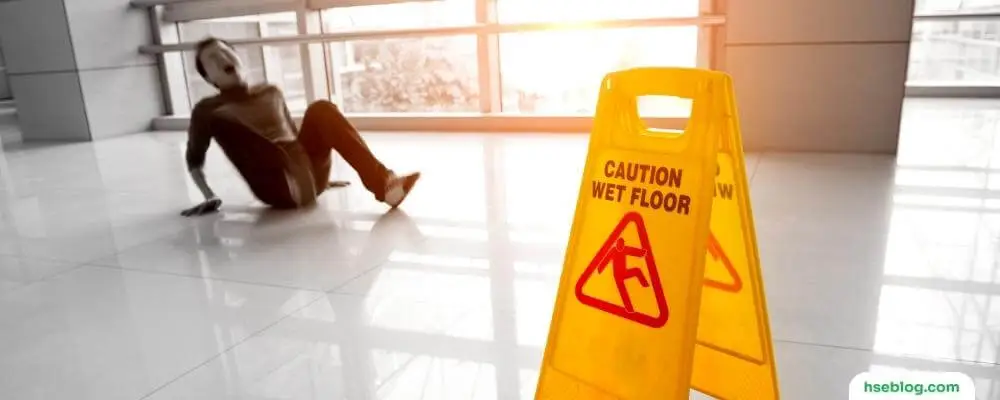
Definition and Differences: Slips, Trips, and Falls
While the terms ‘slips,’ ‘trips,’ and ‘falls’ are often used interchangeably, they refer to distinct occurrences. As we’ve already discussed, a slip occurs when there is insufficient traction between your foot and the walking surface. This lack of grip may cause an imbalance, leading you to fall.
Trips, on the other hand, occur when your foot contacts an object in its path or drops unexpectedly, causing you to lose balance. A trip might occur due to clutter, an obstacle in the pathway, or an uneven walking surface.
Finally, a fall is a sudden, uncontrolled descent for various reasons, including slips, trips, loss of consciousness, or other health-related issues. Falls can occur on the same level (for example, falling on the floor) or from one level to another (like falling down the stairs or from a ladder).
Common Causes of Slips, Trips, and Falls
Understanding the common causes of these incidents is the first step toward prevention. Below are some major factors that often contribute to slips, trips, and falls.
- Wet or Oily Surfaces: One of the most common causes of slips is the presence of wet or oily surfaces. This might occur in areas prone to spills or leaks, such as kitchens, bathrooms, and certain industrial environments.
- Uneven Surfaces, Irregularities, and Obstacles: Uneven walking surfaces or irregularities such as potholes, cracks, or abrupt transitions can cause trips. Obstacles might include clutter, cords, open drawers, and other items that haven’t been stored properly.
- Poor Lighting Conditions: Inadequate lighting can make it difficult to see and avoid potential hazards like spills, obstacles, or changes in level. This can lead to both trips and falls.
- Weather Hazards: Outdoor slips and falls often increase during bad weather conditions such as rain, snow, or ice, which make surfaces slippery and vision less clear.
- Human Factors: Rushing, distraction, fatigue, or lack of proper training can also contribute to slips, trips, and falls. These can often be mitigated through awareness and training.
- Improper Footwear: Footwear unsuitable for the work environment or the current weather conditions can increase the risk of slips, trips, and falls. For example, smooth-soled shoes might not provide enough traction on a wet or oily surface, leading to slips.
- Loose or Unsecured Mats or Rugs: Unsecured mats, rugs, or carpets can shift underfoot or present tripping hazards with their edges.
- Improper Use of Equipment: This might involve using chairs instead of ladders, climbing on shelves, or not using safety equipment correctly, all of which can lead to falls.
- Poor Housekeeping: If work and walkway areas are not kept clean and orderly, they can contribute significantly to slips, trips, and falls. Examples include cluttered workspaces, cables across walkways, or spills not promptly cleaned up.
- Lack of Safety Training: Employees not properly trained on the correct job procedures, including safety equipment, can be at higher risk for accidents.
- Inadequate Maintenance: Neglecting maintenance can lead to hazards such as leaky pipes (leading to wet surfaces), potholes, or uneven flooring, which can cause slips, trips, and falls.
- Poorly Designed Walkways: Walkways with sudden drops, absence of handrails, sharp turns, or inadequate space can increase the risk of falls.
- Medical Conditions: Certain conditions like poor vision, balance disorders, or mobility problems can also increase the risk of slips, trips, and falls.
- Age: Both the very young and the elderly are at an increased risk for falls, partly due to factors such as lack of coordination, decreased strength, or reduced balance.
Remember, while this list of causes is extensive, it is not exhaustive. There may be other contributing factors depending on the specific circumstances or environment. That’s why it’s crucial to carry out regular risk assessments to promptly identify and address potential hazards.
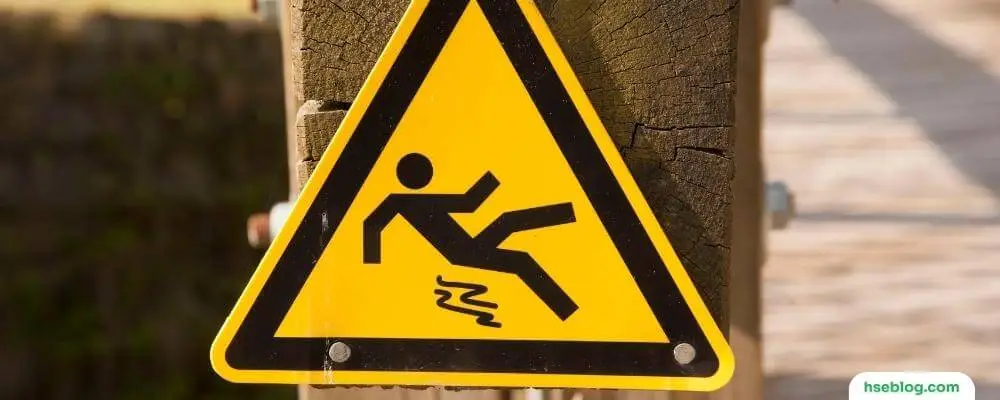
Impact and Consequences Of Slips, Trips, And Falls
The impacts of slips, trips, and falls extend beyond the immediate event and can have lasting effects on the individuals involved and the organizations they belong to. These incidents can result in physical injuries, financial costs, and psychological distress.
Physical Injuries: From Minor to Severe
Physical injuries resulting from slips, trips, and falls can range from minor to severe. Minor injuries may include bruises, abrasions, or sprains. At the same time, more severe cases can lead to fractures, concussions, or even life-threatening injuries such as traumatic brain injuries or spinal cord damage.
In some cases, these incidents can lead to chronic pain or long-term disability, affecting the individual’s ability to perform daily activities or return to work. Falls, in particular, can be especially dangerous for older adults, leading to hip fractures or other serious injuries that significantly impact their independence and quality of life.
Financial Implications: Costs of Accidents
The financial implications of these incidents are also considerable. For individuals, this can include medical expenses, rehabilitation costs, and lost wages during recovery. Additionally, they might face expenses related to modifying their home for accessibility if the fall leads to a long-term disability.
For businesses, the financial costs can be substantial. There are indirect costs besides direct costs like medical expenses and workers’ compensation claims. These can include lost productivity due to employee absence, costs related to training replacement employees, and potential increases in insurance premiums. In severe cases, businesses may also face legal fees if they are negligent in providing a safe environment.
Psychological Implications: Fear and Anxiety After a Fall
The psychological impacts of slips, trips, and falls should not be underestimated. People who have experienced such an incident may develop a fear of falling again. This fear can limit their activities, reduce their independence, and decrease their quality of life.
Anxiety, depression, and social isolation can also result from the fear of falling or the consequences of an injury, such as disability. Employees may experience stress or anxiety about returning to work, especially if they feel the environment is unsafe.
Understanding these impacts highlights the importance of preventive measures to ensure safe environments, reducing the risk of slips, trips, and falls. The following sections will explore strategies to identify potential hazards and implement effective control measures.
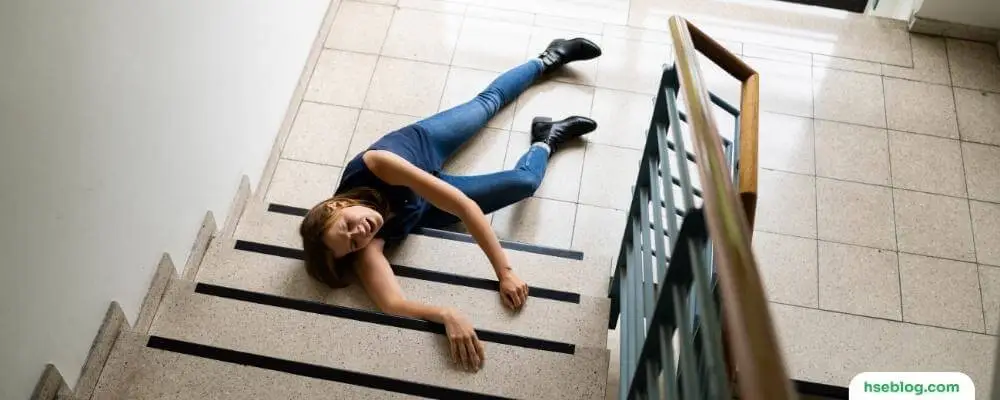
Slips, Trips, And Falls Hazards Risk Assessment
Risk assessment is critical in preventing slips, trips, and falls. It involves identifying potential hazards, evaluating their risks, and determining appropriate control measures. A thorough risk assessment should consider all areas and activities in a given environment, from the home to the workplace.
Identifying High-Risk Areas in the Home or Workplace
High-risk areas vary depending on the setting. These might include staircases, bathrooms, and kitchens in the home, where wet surfaces are common. Outdoor areas like driveways or walkways can also present risks, especially in adverse weather conditions. Any area without sufficient support structures could be risky for older adults or those with mobility issues.
In the workplace, high-risk areas could be those with heavy foot traffic, wet or uneven surfaces, or places with lots of equipment and machinery. Industrial kitchens, construction sites , warehouses, and healthcare facilities are examples of workplace environments that often have high-risk areas.
Key Considerations for Risk Assessment
A comprehensive risk assessment should consider various factors. These include:
- The Environment: Assess the condition of the floors, lighting, staircases, and walkways. Look for hazards like wet surfaces, uneven floors, poor lighting, or lack of handrails.
- Human Factors: Consider the behavior and health of individuals in the environment. Are they rushing? Are they carrying heavy items that may obstruct their view? Do they have any health conditions that increase their risk?
- Tasks: Evaluate the tasks being performed. Does the job involve working at height, handling hazardous substances, or heavy physical labor? Are workers exposed to distractions or time pressure?
- Footwear and Clothing: Assess whether appropriate footwear and clothing are worn for specific environments and tasks.
- Previous Incidents: Look at the history of slips, trips, and falls in the environment. A pattern might indicate a persistent problem that needs addressing.
Importance of Regular Safety Audits
Regular safety audits are essential to maintain a safe environment. These audits involve routinely inspecting the environment and practices to ensure that safety measures are up-to-date and effectively implemented. They help identify new or overlooked hazards and assess the effectiveness of current control measures.
Regular audits also demonstrate a commitment to safety, which can encourage individuals to take responsibility for their safety and that of others. This fosters a proactive safety culture where hazards are promptly reported and addressed, further reducing the risk of slips, trips, and falls.
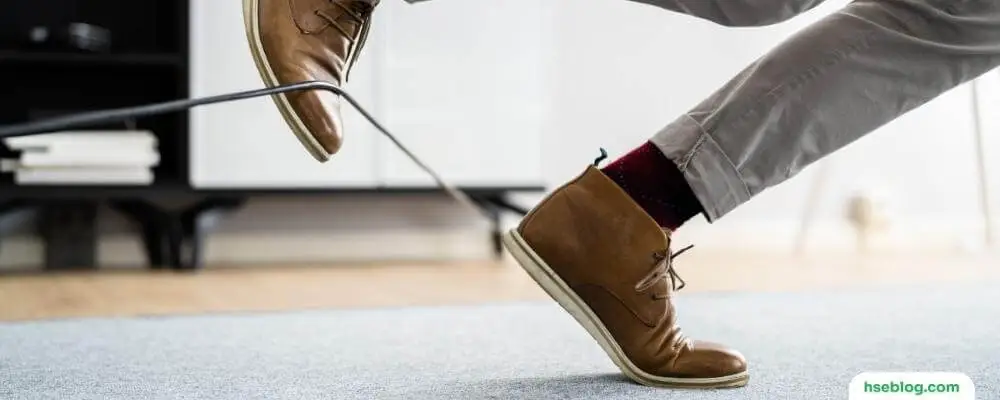
Prevention and Control Measures For Slips, Trips, And Falls
Once potential hazards have been identified through risk assessment, it’s crucial to implement prevention and control measures to mitigate these risks. This involves a range of strategies, from good housekeeping practices to installing safety features.
Housekeeping Best Practices
Proper housekeeping is one of the most effective ways to prevent slips, trips, and falls. Here are some best practices:
- Regular Cleaning: Clean floors regularly and immediately clean up any spills. Ensure to put up “wet floor” signs until the area is dry.
- Declutter: Keep walkways and work areas clear of clutter and obstacles.
- Proper Storage: Store materials and equipment properly when not in use.
- Maintenance: Promptly repair any damages to walkways and work areas, like cracks or uneven surfaces.
Installing Safety Features (Handrails, Non-Slip Mats, etc.)
Installing safety features can greatly reduce the risk of accidents. Here are a few examples:
- Handrails: Install sturdy handrails on all staircases and other areas where individuals may need extra support.
- Non-slip Mats: Use non-slip mats in areas prone to wet or slippery conditions.
- Guard Rails: Install guardrails around elevated platforms, mezzanines, and other fall hazards.
- Visible Markings: Use reflective tape or other visible markings to highlight changes in floor level or other hazards.
Appropriate Footwear for Different Surfaces
Wearing the right footwear can significantly reduce the risk of slips, trips, and falls. Choose shoes with good traction, especially for wet or slippery surfaces. Protective footwear should be worn in workplaces where specific hazards are present, such as construction sites.
Prompt Removal or Correction of Identified Hazards
Address identified hazards as quickly as possible to prevent accidents. If a hazard cannot be immediately removed or corrected, ensure it is clearly marked, and individuals are informed about it until it can be addressed.
Adequate Lighting
Ensure all areas have sufficient lighting to allow individuals to see and avoid potential hazards. This is particularly important for stairways, hallways, and outdoor paths. Replace burnt-out bulbs promptly and consider installing automatic lights in often-used areas.
By implementing these prevention and control measures, you can greatly reduce the risk of slips, trips, and falls, promoting a safer environment for everyone. In the next section, we’ll explore additional strategies and considerations specific to the workplace.
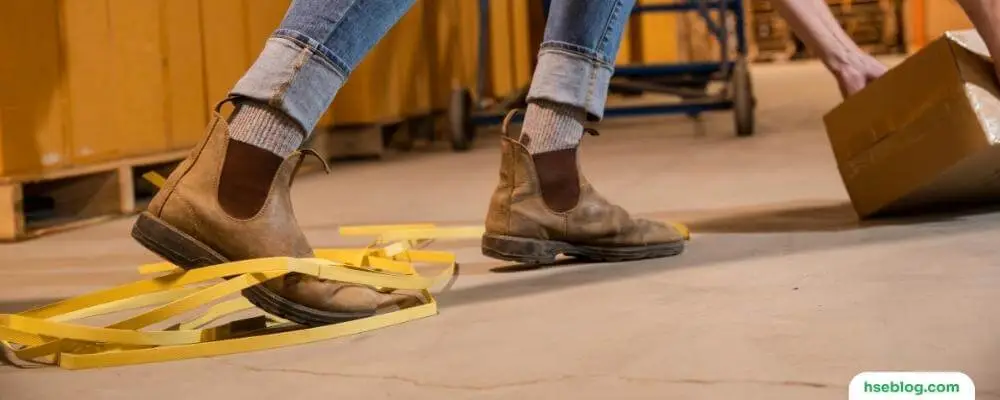
Workplace-Specific Considerations
While many of the principles of slips, trips, and falls prevention apply universally, certain considerations are particularly relevant to workplaces. These involve safety training, employer responsibilities, and industry-specific hazards.
Importance of Safety Training and Awareness Programs
Safety training is vital to workplace safety . Regular training sessions can ensure that employees are aware of potential hazards and the best practices for avoiding them. Training should cover topics such as proper use of equipment, safe handling of materials, and emergency procedures.
Awareness programs, too, can play a crucial role in maintaining a safe work environment. These programs could include regular safety reminders via bulletins, emails, or meetings, encouraging employees to be vigilant and proactive about safety.
Employer Responsibilities and Employee Rights
Employers have a responsibility to provide a safe work environment. This involves conducting regular risk assessments, addressing identified hazards promptly, and providing necessary safety training and equipment. They should also have procedures in place for reporting accidents or hazards and ensure that employees feel comfortable using these procedures without fear of retaliation.
Employees, on the other hand, have the right to a safe workplace and the right to speak up about safety concerns. They also have a role in maintaining safety by following established procedures, using provided safety equipment, and promptly reporting any hazards or incidents.
Industry-Specific Hazards and Control Measures
Every industry has its unique set of hazards, so it’s important to consider these when planning prevention and control measures. For example, spills and hot surfaces might be major hazards in a restaurant kitchen. Measures could include non-slip mats, appropriate footwear, and caution signs. In a construction site, falls from a height might be the primary concern, necessitating guardrails, safety harnesses, and fall arrest systems.
In conclusion, slips, trips, and falls are common but preventable incidents. By understanding their causes and impacts, conducting regular risk assessments, and implementing effective prevention and control measures, we can significantly reduce these accidents, fostering safer homes, workplaces, and communities.
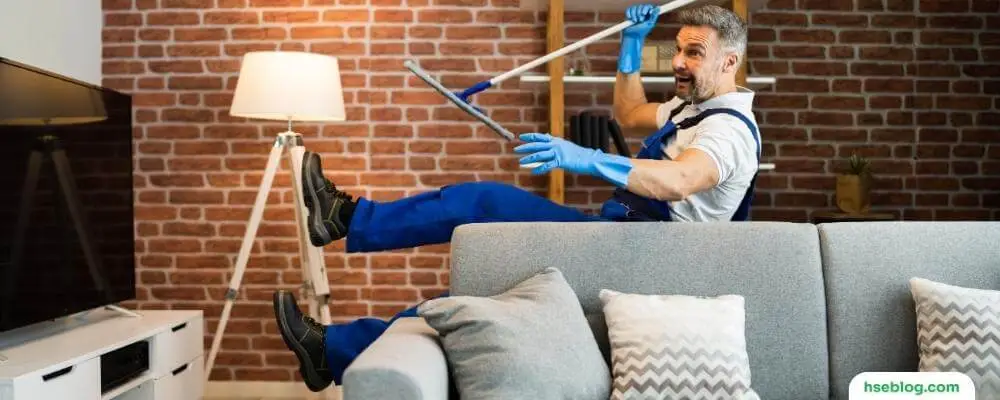
Preventing slips, trips, and falls is no small task, but it is a crucial one. As we’ve explored in this guide, these incidents are far from trivial, carrying the potential for serious physical injuries, significant financial costs, and profound psychological impacts. Yet, armed with the knowledge of what causes these incidents and understanding their impacts, we’re already halfway towards prevention.
The steps to creating safer environments—at home, in public spaces, or at workplaces—aren’t overly complex. They begin with recognizing the potential hazards and involve a thoughtful blend of risk assessment, implementing practical measures, and fostering a culture of safety awareness. From basic housekeeping to installing safety features, each action reduces the risk.
It’s important to remember that the responsibility of preventing slips, trips, and falls doesn’t rest on a single individual or group—it’s a collective effort. Employers, employees, homeowners, and public facility managers all have roles to play. And in our various roles, we all contribute to a larger, shared goal: creating safer environments for everyone.
Preparing for and preventing these incidents can seem daunting in a world where the unexpected is expected. But, as we’ve seen, it’s not only possible; it’s a critical part of our commitment to safety for ourselves and others. Let this guide serve as a reminder and resource for that commitment, helping us make each step we take a safer one. Thank you for joining us on this journey towards safer environments and greater awareness. Let’s continue to take steps, big and small, toward a safer tomorrow.
- +1 (800) 826-0777
- VIRTUAL TOUR
- Mass Notification
- Threat Intelligence
- Employee Safety Monitoring
- Travel Risk Management
- Emergency Preparedness
- Remote Workforce
- Location and Asset Protection
- Business Continuity
- Why AlertMedia
- Who We Serve
- Customer Spotlights
- Resource Library
- Downloads & Guides
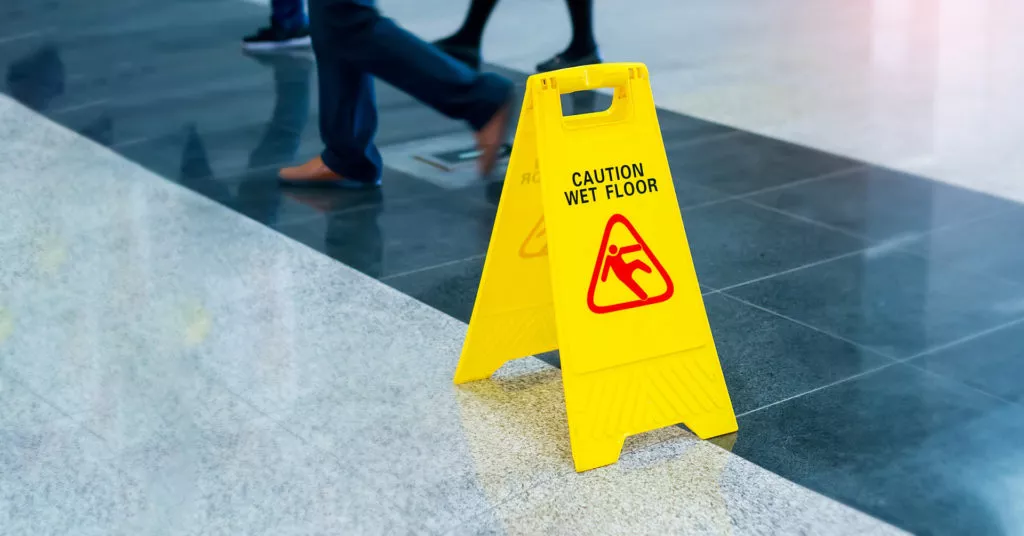
Prevent Workplace Slips, Trips, and Falls—8 Safety Tips
Mopping up a spill or double-checking a guardrail might seem like simple common sense, but slips, trips, and falls are the second most common cause of death at work. These are life-saving procedures. Keep reading for practical tips to prevent workplace accidents.
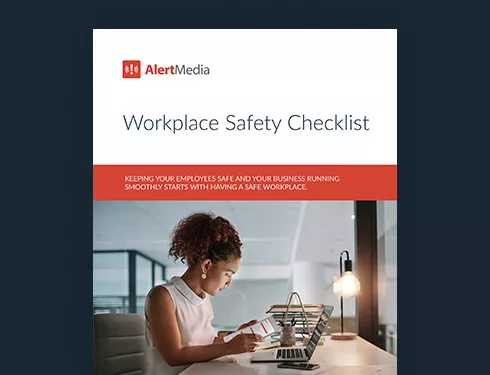
- Slip, Trip, and Fall Hazards Listed
- Clarifying OSHA Standards
- Prevent Workplace Slips, Trips, and Falls
These are familiar scenarios at home: slipping on a wet floor in the kitchen and tripping over a toy left out by the kids. While annoying, these accidents are typically minor hazards in the home. You might stub your toe, but rarely are there severe consequences.
In the workplace, it’s a different and far more serious story. Slips, trips, and falls account for over 200,000 workplace injuries per year. In 2020, nearly one in five accidents leading to missed work was due to a slip, trip, or fall. They’re also the second-leading cause of workplace fatalities.
As a safety leader, you’re responsible for your company’s duty of care and for providing a safe workplace . This blog post will examine common hazards leading to slips, trips, and falls and the steps you can take to minimize injury risks for your team.
Download Our Workplace Safety Checklist
What are slip, trip, and fall hazards in the workplace.
Accidents involving slips, trips, and falls are often grouped together. While they’re similar, it’s important to understand the distinction since they each have different causes and consequences.
Slips occur when someone’s footwear loses traction with the surface they’re on, causing a loss of balance. Under some circumstances, slipping can lead to a fall.
Trips happen when someone hits their foot or lower leg on an object. As their upper body continues moving forward while their lower body remains stationary, the person may lose their balance in the process.
Falls often result from slips or trips, but they can also happen on their own. For example, a worker on a ladder or scaffolding can lose their balance and fall without slipping or tripping. Falls are also possible on flat surfaces and can still cause serious injuries.
Once you understand the hazards that lead to each type of accident, you can identify and mitigate risks in your workplace. Here are some of the most common causes of slips, trips, and falls in the workplace:
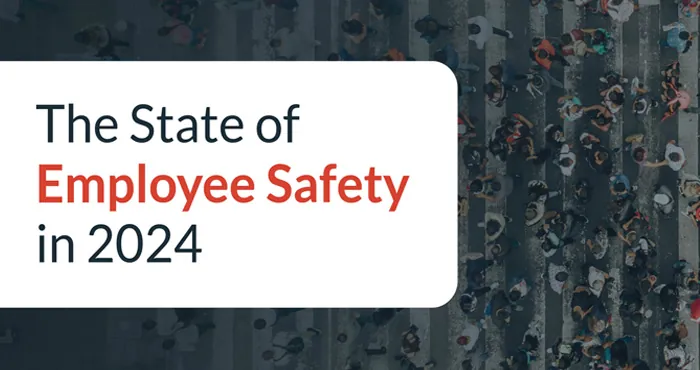
Slip Hazards
- Spills of wet or dry substances
- The cleaning process during spill removal
- Employees rushing or not paying attention to workplace conditions, especially while carrying objects
- Slippery floor surfaces such as marble or laminate
- Wet surfaces
- Poor lighting that obscures hazards
- Inappropriate footwear for the environment
- Transitioning between different types of surfaces
Trip Hazards
- Objects or obstructions in walkways
- Uneven surfaces on flooring or concrete
- Cables, cords, and hoses that aren’t properly secured or organized
- Unmarked steps or ramps
- Irregular stairs or stairs without railings
- Carpet, rugs, or mats with wrinkles or lifted edges
Fall Hazards
- Improperly used or poorly maintained ladders
- Elevated surfaces without guardrails
- Floor and wall openings
- Working in elevated environments without a safety harness
- Ill-fitting or improperly used PPE, such as helmets and safety lines
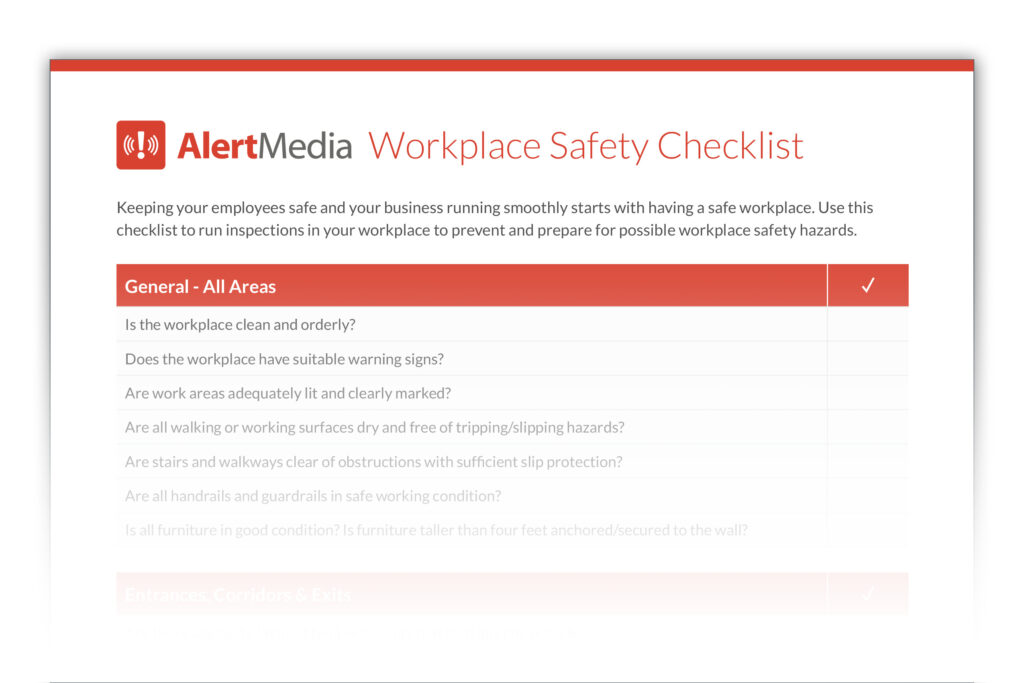
Preview the Workplace Safety Checklist
Are There OSHA Standards Related to Slips, Trips, and Falls?
Despite how common these injuries are, there is no specific OSHA standard on slips, trips, and falls. However, several OSHA rules indirectly address the same hazards.
The most important regulation to be aware of is 29 CFR 1910 Subpart D, which covers walking and working surfaces. OSHA updated the standard in 2017, introducing many upgrades to fall protection system requirements, improved employer-provided inspection guidelines, and a greater emphasis on safety training for employees.
For the construction industry, 29 CFR 1916 contains numerous fall-related regulations. Subpart M specifically addresses fall prevention, but other sections, such as Subpart L (scaffolds) and Subpart E (personal protective and lifesaving equipment), are also relevant. OSHA used 29 CFR 1916 as guidance when revising 29 CFR 1910, so the two guidelines now reflect many of the same OSHA violations .
As with any other workplace hazard or accident, OSHA recordkeeping requirements still apply in the event of a slip, trip, or fall incident. Internally, the reporting process is also an opportunity to review the details of the incident and determine how you can update your workplace safety policy to prevent similar accidents in the future.
How to Prevent Slips, Trips, and Falls in the Workplace
Many hazards that cause slips, trips, and falls are inevitable. However, injuries and accidents are not. To prevent slips, trips, and falls, train your employees to follow a three-step process:
- Recognize the hazard: Identify conditions that could lead to a slip, trip, or fall.
- Evaluate the hazard: Examine the situation and determine what level of risk it presents and who it affects.
- Control the hazard: Avoid the risk by removing the hazard (such as mopping up a spill) or implementing safety equipment and procedures (such as installing handrails on an elevated platform).
Here are eight workplace safety tips to prevent falls, trips, and slips.
1. Teach situational awareness
Since many causes of slips, trips, and falls are foreseeable, situational awareness in the workplace is one of the best preventative measures. Encourage your employees to pay attention to their surroundings and the risks they present:
- Look at walking surfaces for spills, obstacles, or other potential hazards
- Watch for signage that warns of increased hazards
- Be aware of conditions such as weather or time of day that might increase the risk of an accident
- Take shorter and more cautious steps on slippery surfaces
2. Encourage proper footwear
Like any other form of PPE, proper footwear can significantly reduce the risk of accidents. Research has found that slip-resistant shoes can reduce injury claims by 67% in environments with slippery work surfaces.
Employees should regularly inspect their shoes and make sure the soles aren’t worn out, as the lack of tread increases the danger of slipping. Additionally, anyone who works in conditions exposed to winter weather hazards should wear insulated boots. Cold temperatures can decrease muscle function, increasing the risk of slipping, tripping, or falling.
3. Utilize signage
Signage is an effective warning system for many workplace risks, but it can be especially effective in preventing slips, trips, and falls. There are two types of signs you can use to increase occupational safety:
- Temporary: Use warning signs while addressing a new hazard, such as cleaning up a spill, repairing a handrail, or replacing a ripped carpet. While temporary signage can help prevent injuries, you still need to address the actual hazard as quickly as possible.
- Permanent: For unavoidable hazards, such as slippery surfaces, a permanent sign can help warn employees to be careful. Use these sparingly, though, as it’s easy for people to ignore signs they see every day.
4. Keep floors clear and clean
Good housekeeping can help prevent most slips, trips, and falls. The details of keeping walking areas clean will vary widely by work environment, but there are a few common themes to encourage workplace safety:
- Report spills immediately, and warn nearby employees until someone can clean the contaminated surface
- Keep walkways clear of obstacles, loose objects, and anything that someone could trip over
- Place mats at entrances and exits so people can dry their shoes and avoid tracking water or other substances around the workplace
- Install handrails on stairways and elevated walkways
5. Apply non-slip mats and coatings
In some situations, keeping floors from becoming slippery is nearly impossible. Whether it’s liquid splashing or steam condensing, you must focus on mitigating the risk rather than avoiding it altogether.
For smaller or less demanding settings, non-slip mats can help employees maintain traction while walking around. In other cases, treating the floor with a permanent coating can help reduce slipping risks, even in the constant presence of liquids.
Who is at risk for slips, trips, and falls?
While all industries have some level of risk for a slip, trip, or fall, there are some industries where the risk is much higher, and the potential result could be much more dangerous. Here are some of the highest-risk industries:
- Construction
- Manufacturing
- Transportation/shipping/logistics
- Outdoor maintenance/groundskeeping
- Foodservice/hospitality
6. Ensure proper lighting
To identify slip, trip, and fall hazards, your employees need to be able to see their surroundings. Make sure that all of your work areas have proper lighting, especially in areas that are more prone to unsafe conditions.
While this can be a challenge in outdoor work environments, especially at night, it’s even more critical in those situations. Environmental conditions can lead to increased risks, and employees need to be able to see and avoid them. Adequate lighting should also extend to parking lots and walking areas around your facilities.
7. Develop safety programs
Your company’s safety plans and programs should include specific guidelines for preventing slips, trips, and falls. There are a few key topics to consider when developing these policies:
- The types of surfaces employees work and walk on and whether they present extra risks
- Seasonal or regional conditions that could heighten hazards, such as winter weather threats
- Specific OSHA regulations that apply to your workplace
- Potentially hazardous equipment training such as ladder safety
- Regular inspection plans to ensure your team is maintaining a safe work environment
- Policies to report hazards using your company’s two-way communication platform
- First aid training , so employees are prepared to respond safely should injuries occur
8. Provide Slips, Trips, and Falls Training
Lastly, training your employees to avoid slips, trips, and falls will help keep them safe. Provide specific guidance on the environments they’ll work in and the hazards they’ll face. For example, a slips, trips, and falls safety talk for food service workers should focus on wet floors and walking safely in crowded, fast-paced environments. Conversely, office workers could use extra reminders to watch for stray power cords and keep walkways clear of boxes, files, and other tripping hazards.
Working slips, trips, and falls into your safety topics for meetings is also helpful. Regular safety talks or safety moments are an excellent opportunity to remind your team about seasonal risks or update them on newly installed safety measures.
Don’t Let Your Safety Standards Slip
Slips, trips, and falls are some of the most common workplace injuries. Fortunately, you can usually prevent them with proper planning and safety measures.
By making slip, trip, and fall prevention a part of your company’s safety culture, you can ensure your employees are aware of their surroundings and ready to look out for each other’s safety. Enable them to report hazards easily, address risks quickly, and train them to avoid situations that are likely to cause injury.
With the right planning and prevention, even the most intense work environments can be as safe as a walk in the park.
More Articles You May Be Interested In
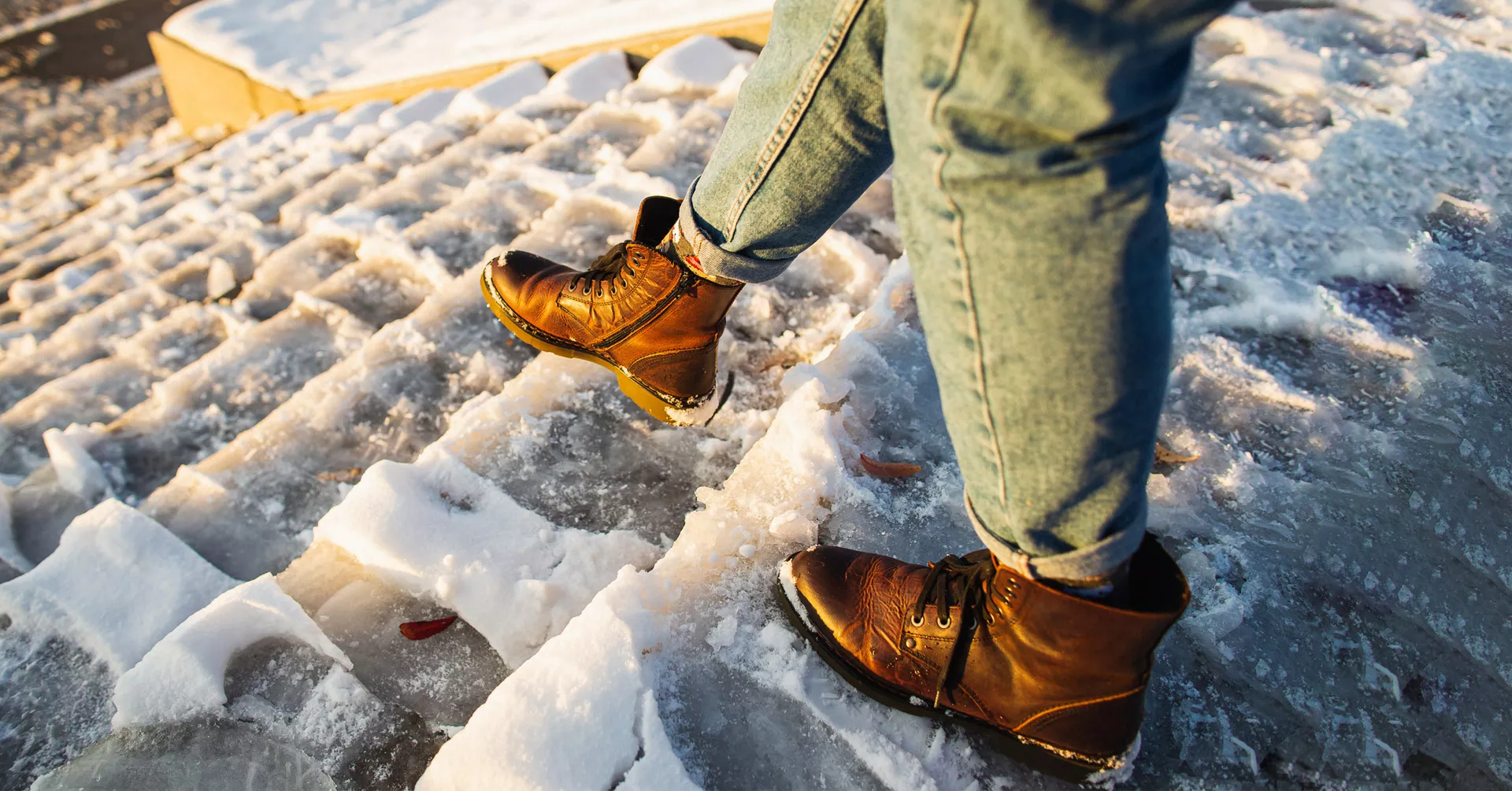
Workplace Safety Checklist
Please complete the form below to receive this resource.
Check Your Inbox!
The document you requested has been sent to your provided email address.
Cookies are required to play this video.
Click the blue shield icon on the bottom left of your screen to edit your cookie preferences.

Contact | Subscribe | Media centre

- Lifting, pushing and pulling
- Psychosocial hazards
- Working at heights
- Crystalline silica and silicosis
Managing health and safety
- Identify, assess and control hazards
- Safety data sheets
- Personal protective equipment
- Emergency plans and procedures
- Incident reporting
Industry and business
- Construction
- Small business
- Agriculture
- Gig economy
The Commonwealth, states and territories regulate and enforce WHS laws.
Find your Regulator
Model WHS Laws
We created the model WHS laws in 2011.
- Model WHS Act
- Model WHS Regulations
- Duties under Model WHS laws
- Codes of Practice
- Legislation
WHS laws in your jurisdiction
Contact your regulator
Data and Research
We collect, analyse and publish data and information on work health and safety and workers' compensation.
See our data
- Work-related fatalities
- Work-related injuries
- Work-related diseases
- Return to Work
- Explore our data
- About our data
- Industry benchmarking
- Research by industry or topic
See our latest Key work health and safety statistics
explore our data
Workers' Compensation
We develop national policy and strategy about workers' compensation.
- Workers’ compensation
- Comparing workers' compensation in Australia
- National Return to Work Strategy
- Deemed diseases
- Permanent impairment
- Workers' compensation for psychological injury

Read the Strategy
Resources and Publications
We publish a wide range of resources covering many work health and safety topics.
- Codes of practice
- Video and audio
- Corporate publications
Media centre
- Media releases
- News update
Read our Codes of Practice
read the codes
Slips, trips and falls
Each year slips, trips and falls cause thousands of preventable injuries.
- Safety by topic
The most common ones are:
- musculoskeletal injuries (injuries to muscles, nerves, tendons, joints, cartilage and spinal discs)
- bruises
- fractures
- dislocations.
More serious injuries and deaths can also happen.
Slip, trip and fall hazards
Some things that can cause you to slip are:
- the wrong footwear
- polished, wet or greasy floors.
In most cases, people trip on low obstacles that are hard to spot, such as:
- uneven edges in flooring
- loose mats
- open drawers
- untidy tools, or
- electrical cables.
Falls can result from a slip or trip, but many occur from low heights. For example:
- steps
- stairs
- kerbs,
- holes
- ditches, or
- wet or slippery surfaces.
WHS duties
As a person conducting a business or undertaking (PCBU), you must always aim to eliminate the risk of slips, trips and falls, so far as is reasonably practicable. If that is not possible, you must minimise risks so far as is reasonably practicable.
You must identify hazards, and assess and control risks. Think about your:
- work areas
- work procedures
- tools
- equipment.
Consulting with workers can help you find better and easier ways to identify and minimise risks. You should also review control measures to ensure they are working as planned.
Workers also have duties, including taking reasonable care for their own health and safety.
Managing risks
The best way to manage the risk of slips, trips and falls is to eliminate hazards at the design stage of the workplace.
If you can’t eliminate the risk, you must minimise it so far as is reasonably practicable.
Designing safe workplaces
In designing floors, stairs, lighting, drainage and storage:
- keep floors at a single level and use slip-resistant floor coverings
- install extra power points to avoid trip hazards from trailing cords
- ensure all areas are well lit, particularly stairwells
- have good drainage and slip resistant grates
- have lots of storage, so things aren’t left in walkways.
Safe work procedures
Work procedures can also impact on the incidence of slips, trips and falls. Have clear procedures to:
- remove rubbish to avoid trip hazards
- return tools and other items to their storage areas after use
- report and clean spills
Keep the workplace clean
All workers share responsibility for keeping the workplace clean and tidy.
Make sure you:
- have adequate rubbish and recycling bins
- have cleaning schedules in place
- dry floors after cleaning
- don’t have cords on walkway or work area floors.
Training
Training helps workers become more aware of slip and trip hazards and helps to prevent injuries.
Training should include:
- awareness of slip and trip hazards
- identifying effective control measures
- duties of workers.
Using personal protective equipment (PPE)
As a PCBU, you should only use PPE:
- after you have implemented all other possible control measures.
- as an interim measure until you can use a better control measure
- as a backup in addition to other control measures.
Slip-resistant footwear
Slip-resistant footwear is a type of PPE.
Slip-resistant footwear should be appropriate for the work and workers must wear it properly.
In wet conditions, the shoe sole tread should:
- be deep enough to help penetrate the surface water
- make direct contact with the floor.
In dry conditions, the shoe sole tread:
- pattern should be a flat bottom construction
- should grip the floor with maximum contact area.
Types of slip-resistant footwear
Urethane and rubber soles are more slip resistant than vinyl and leather soles.
Sole materials that have tiny cell like features are slip resistant.
Supporting information
- Model Code of Practice: How to manage work health and safety risks
- Model Code of Practice: Managing the work environment and facilities
- Slips and trips at the workplace fact sheet
- The interactive safe work method statement (SWMS) tool provides information on preparing, using and reviewing SWMS for high risk construction work.
News related to this topic
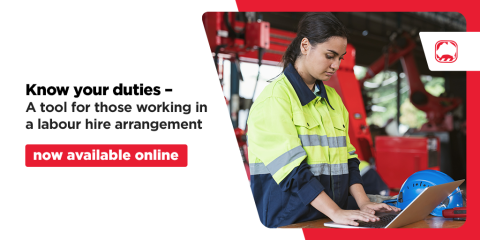
01 Dec 2023 | News
Do you use labour hire?
Read more >
See all news
Further Advice
SWA is not a regulator and cannot advise you about WHS issues in the workplace. If you need help please contact your state or territory work health and safety authority .
We develop national policy relating to WHS and workers' compensation.
Slips, trips and falls
Ground clutter, uneven or slippery floor surfaces, poor lighting or lack of signage all contribute to thousands of workers getting injured every year
How are workers and others harmed?
Slips, trips and falls are one of the most common cause of injuries for workers and injuries can happen in a number of ways, for example:
- unmarked changes in floor levels
- slipping on a wet floor (which is wet because something is spilt on it, or because of weather conditions or cleaning processes)
- poor housekeeping and obstructed views – leading to people tripping over loose carpet, mats, trailing cables, boxes or bags
- damaged flooring including stairs
- not using stair hand rails
- cramped conditions and poor work flow (eg desks too close together)
- standing on unstable furniture
- poor lighting.
What can you do?
First you must always eliminate the risk where you’re reasonably able to. Where you’re not reasonably able to, then you need to consider what you can do to minimise the risk. Here are some examples:
- Keep work and storage areas tidy.
- Ensure designated walkways are provided with good conditions under foot, signposted and adequately lit.
- Use mechanical lifting aids rather than carrying heavy or unwieldy loads that block the view ahead.
- Ensure workers wear appropriate footwear with good grip.
- Plan deliveries to minimise the amount of materials on site.
- Have designated areas for waste collection, and provide skips and bins. Make sure everyone knows who is responsible for waste removal.
- Use cordless tools where possible. If you need to use cables for temporary lighting or power tools, run the cables at a high level.
- Treat slippery surfaces with stone or grit, depending on the conditions. Make sure you signpost any slippery areas.
- Consider using a ramp for any changes in level. Where this is not possible, use signs to warn workers to look out for a level change.
You need to select the most effective controls that are proportionate to the risk, and appropriate to your work situation.
Get your workers involved
- Ensure your workers know how to make suggestions, ask questions, or raise concerns.
- Always ask your workers for input on identifying health and safety risks and how to eliminate or minimise them. People are more likely to take responsibility and make good decisions when they have been involved in the conversation. Your workers (including contractors and temps) are the eyes and ears of your business. They can help spot issues, and suggest practical, cost-effective solutions.
- Always train your workers on what the key risks are and how to keep healthy and safe.
Find out more about getting your workers involved
Where to go for more information
Slips, trips and falls | WorkSafe Victoria (external link)
Slips and trips | Health and Safety Executive (HSE) UK (external link)
Slips, trips and falls | WorkSafe British Columbia (external link)
Related information
Case studies.
Case studies showing how NZ businesses are finding innovative ways to involve workers in workplace health and safety, manage work-related health risks and keep health and safe at work.
How to manage work risks
Different businesses will have different health and safety risks. The risks you need to identify, assess and manage depend on the type of work you do.
Preventing slips trips and falls on farms
General advice on how to manage slip, trip and fall hazards. It covers working at height, using ladders, and slips, trips and falls on flat ground
Worker engagement and participation
All businesses and undertakings must involve their workers in workplace health and safety.
Last updated 2 November 2017 at 08:30

- Search search
- Slips Trips and Falls
- Preventing Slips Trips and Falls
Preventing Slips, Trips and Falls
Learn what you can do to prevent and control slip, trip and fall hazards in the workplace.
Page Content
Slip, trip and fall hazards, for more information.
Slips, trips and falls can happen in any workplace, and should not be overlooked. They can cause:
- Minor injuries such as sprains and strains.
- Broken bones due to the impact when trying to break the fall.
- Back injuries due to the impact from the fall.
- Cuts if the incident occurs near sharp objects.
- Head injuries if the person hits the head upon impact.
- Burns if the incident occurs near hot surfaces, or if the person is handling hot fluids.
- Death in more serious cases. For example, a person may slip and fall off an open side of a building if it is not barricaded.
The table below lists:
- Hazards associated with slips, trips and falls.
- Examples of risk control measures that your risk assessment team can take to minimise or eliminate the risks associated with these hazards.
Employer's Role
- Conduct Risk Assessments (RA) to eliminate or minimise slip, trip and fall risks.
- Maintain a safe work environment (e.g. by selecting the right type of non-slip flooring and providing sufficient illumination at the workplace).
- Provide employees with personal protective equipment (e.g. non-slip work shoes), training, instruction and supervision for relevant work activities.
To improve workplace practices, you should also:
- Establish clear standards for workplace housekeeping and set an expectation for employees to maintain them. Refer to the WSH Guidelines on Workplace Housekeeping for more information.
- Conduct routine workplace inspections to confirm that all hazards have been addressed, and to ensure that your risk control measures have been effectively implemented.
- Encourage employees to report near-miss incidents so that you can prevent future accidents.
- Encourage employees to submit ideas on slip, trip and fall prevention through a WSH staff suggestion scheme.
Employee's Role
- Adhere to safe work procedures and instructions.
- Not endanger yourself or others with unsafe behaviour (e.g. running across a wet floor or using a handphone while walking down the stairs).
- Use personal protective equipment (e.g. non-slip work shoes) provided by your company.
- Clean up all spills promptly.
- Keep walkways and staircases free of obstacles.
- Keep the floor in the work area dry, clean and free from clutter.
- Tape down power cords or cables to prevent tripping.
- Report any hazards you spot (e.g. damaged floor tiles, curled mats), and place a warning sign to alert others before the hazard is removed.
- Report all near misses and accidents promptly to your employer.
- Submit suggestions on slip, trip and fall prevention.
- ABC Checklist – Slips, Trips and Falls
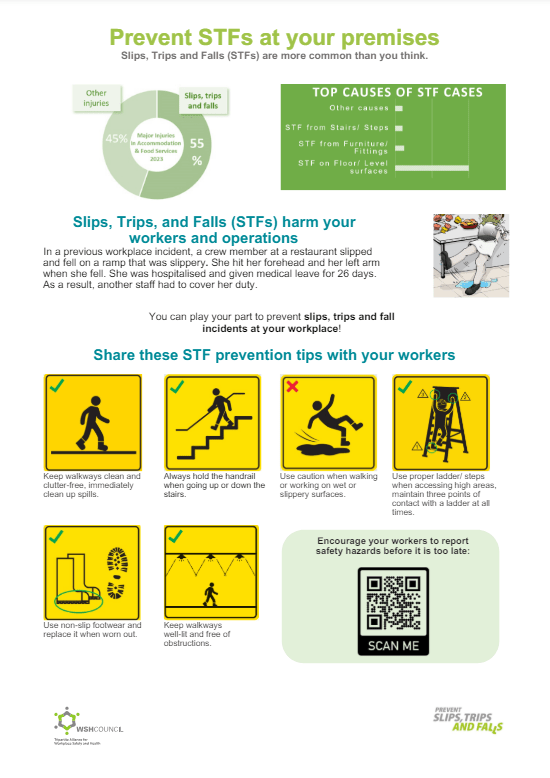
05 Jun 2024 Collaterals Posters
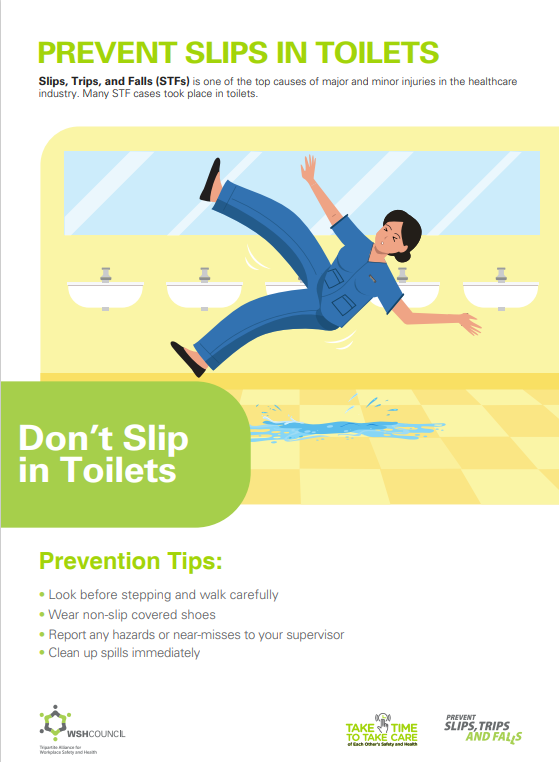
31 May 2024 Collaterals Posters
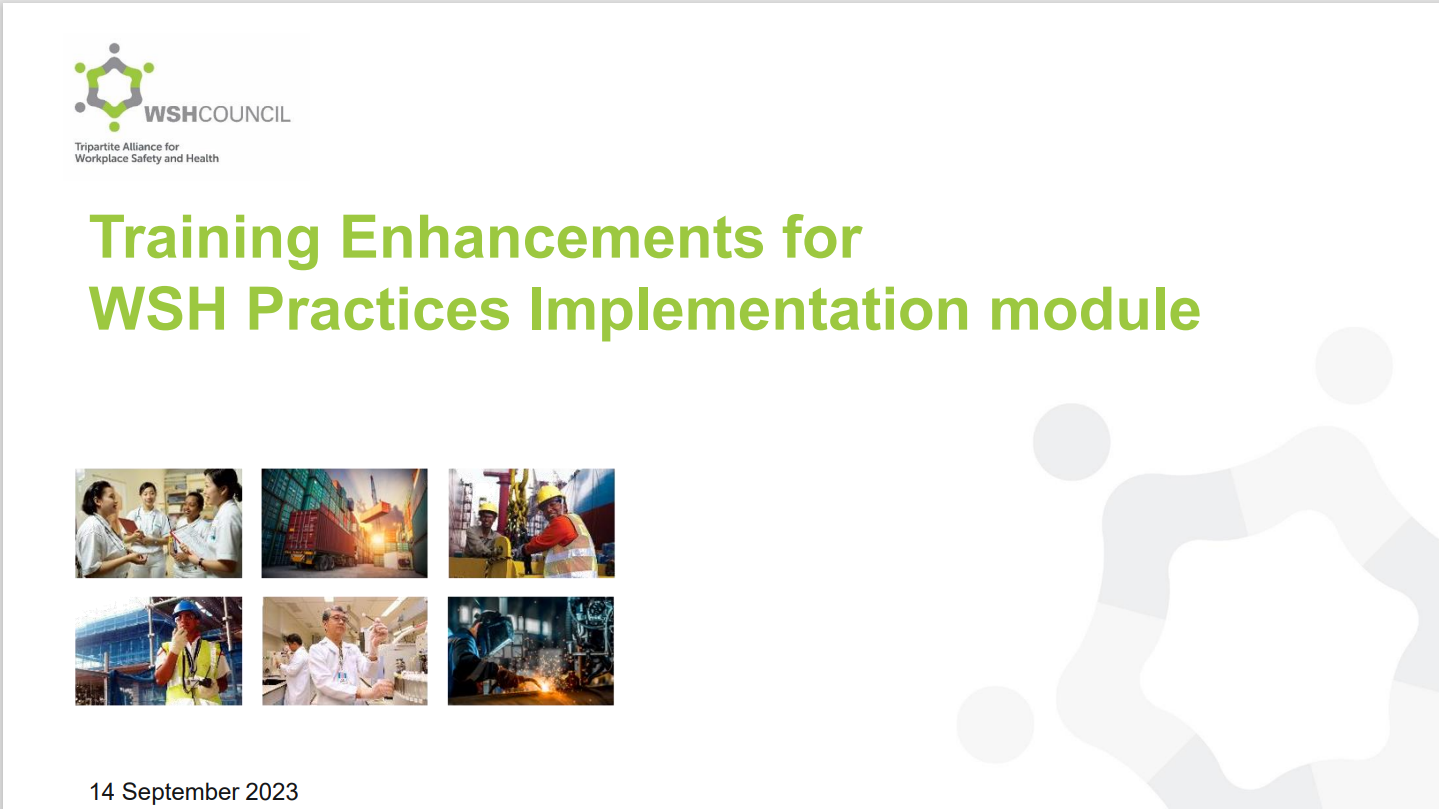
19 Apr 2024 Training Materials Resources for Training Providers
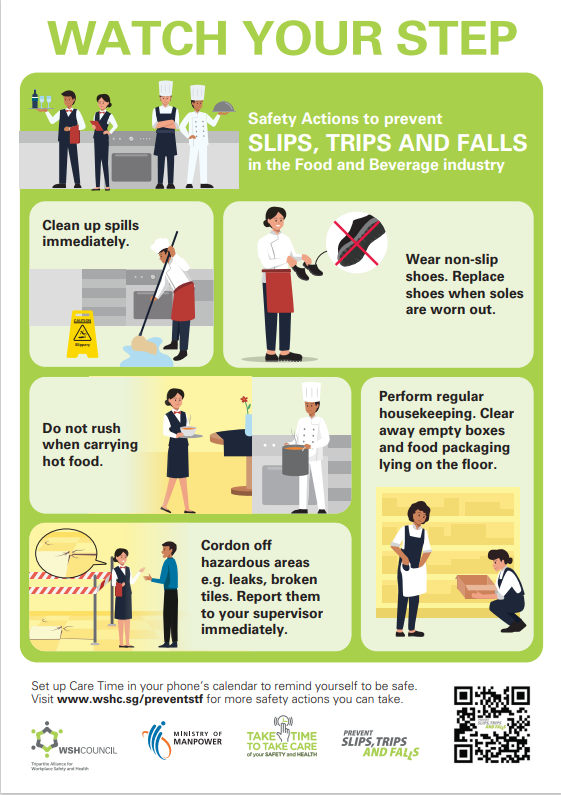
04 Oct 2023 Collaterals Posters
Advisory – Beware of scams and phishing emails
Send us feedback if you receive any suspicious or inappropriate emails asking for your personal information. The email may not have been sent by Workplace Safety and Health Council. Do not click on any link or open any attachments. Your feedback can help us fight against scammers – contact us immediately. We use cookies on wshc.sg to provide a better user experience that's more tailored to you. If you continue, you are giving us your consent to receive cookies only on this site. To decline cookies at any time, simply adjust your browser settings. Read our Privacy Statement.
Appointments at Mayo Clinic
- Healthy aging
Fall prevention: Simple tips to prevent falls
Falls put you at risk of serious injury. Prevent falls with these simple fall prevention measures, from reviewing your medications to hazard-proofing your home.
Fall prevention is an important topic to consider as you get older. Physical changes and health conditions — and sometimes the medications used to treat those conditions — make falls more likely as you age. In fact, falls are a leading cause of injury among older adults. Still, fear of falling doesn't need to rule your life. Instead, consider six simple fall prevention strategies.

1. Make an appointment with your health care provider
Start by making an appointment with your health care provider. To assess your risk and discuss fall prevention strategies, your health care provider may want to talk about the following:
- Your medications. Make a list of your prescription and nonprescription medications and supplements, or bring them with you to the appointment. Your health care provider can review your medications for side effects and interactions that may increase your risk of falling. To help with fall prevention, your health care provider may consider weaning you off medications that make you tired or affect your thinking, such as sedatives, antihistamines and some types of antidepressants.
- Any previous falls. Write down the details, including when, where and how you fell. Be prepared to discuss instances when you almost fell but were caught by someone or managed to grab hold of something just in time. Details such as these may help your health care provider identify specific fall prevention strategies.
- Your health conditions. Certain eye and ear disorders may increase your risk of falls. Be prepared to discuss your health conditions and how comfortable you are when you walk — for example, do you feel any dizziness, joint pain, shortness of breath, or numbness in your feet and legs when you walk? Your health care provider may evaluate your muscle strength, balance and walking style (gait) as well.
2. Keep moving
Physical activity can go a long way toward fall prevention. With your health care provider's OK, consider activities such as walking, water workouts or tai chi — a gentle exercise that involves slow and graceful dance-like movements. These activities reduce the risk of falls by improving strength, balance, coordination and flexibility.
If you avoid physical activity because you're afraid it will make a fall more likely, tell your health care provider. Your provider may recommend carefully monitored exercise programs or refer you to a physical therapist. The physical therapist can create a custom exercise program aimed at improving your balance, flexibility and muscle strength.
3. Wear sensible shoes
Consider changing your footwear as part of your fall prevention plan. High heels, floppy slippers and shoes with slick soles can make you slip, stumble and fall. So can walking in your stocking feet. Instead, wear properly fitting, sturdy, flat shoes with nonskid soles. Sensible shoes may also reduce joint pain.
4. Remove home hazards
Take a look around your home for potential fall hazards. To make your home safer:
- Remove boxes, newspapers, electrical cords and phone cords from walkways.
- Move coffee tables, magazine racks and plant stands from high-traffic areas.
- Secure loose rugs with double-faced tape, tacks or a slip-resistant backing — or remove loose rugs from your home.
- Repair loose, wooden floorboards and carpeting right away.
- Store clothing, dishes, food and other necessities within easy reach.
- Immediately clean spilled liquids, grease or food.
- Use nonslip mats in your bathtub or shower. Use a bath seat, which allows you to sit while showering.
5. Light up your living space
Keep your home brightly lit to avoid tripping on objects that are hard to see. Also:
- Place night lights in your bedroom, bathroom and hallways.
- Place a lamp within reach of your bed in case you need to get up in the middle of the night.
- Make clear paths to light switches that aren't near room entrances. Consider trading traditional switches for glow-in-the-dark or illuminated switches.
- Turn on the lights before going up or down stairs.
- Store flashlights in easy-to-find places in case of power outages.
6. Use assistive devices
Your health care provider might recommend using a cane or walker to keep you steady. Other assistive devices can help, too. For example:
- Handrails for both sides of stairways
- Nonslip treads for bare-wood steps
- A raised toilet seat or one with armrests
- Grab bars for the shower or tub
- A sturdy plastic seat for the shower or tub — plus a hand-held shower nozzle for bathing while sitting down
If necessary, ask your health care provider for a referral to an occupational therapist. An occupational therapist can help you brainstorm other fall prevention strategies. Some solutions are easily installed and relatively inexpensive. Others may require professional help or a larger investment. If you're concerned about the cost, remember that an investment in fall prevention is an investment in your independence.
- Kiel DP. Falls in older persons: Risk factors and evaluation. https://www.uptodate.com/contents/search. Accessed Dec. 29, 2021.
- Falls in older people. Merck Manual Professional Version. https://www.merckmanuals.com/professional/geriatrics/falls-in-older-people/falls-in-older-people. Accessed Dec. 29, 2021.
- Important facts about falls. Centers for Disease Control and Prevention. https://www.cdc.gov/homeandrecreationalsafety/falls/adultfalls.html. Accessed Dec. 29, 2021.
- Ferri FF. Falls in the elderly. In: Ferri's Clinical Advisor 2022. Elsevier; 2022. https://www.clinicalkey.com. Accessed Dec. 29, 2021.
- AskMayoExpert. Falls (adult). Mayo Clinic; 2021.
- Prevent falls and fractures. National Institute on Aging. https://www.nia.nih.gov/health/prevent-falls-and-fractures. Accessed Dec. 29, 2021.
- Fall-proofing your home. National Institute on Aging. https://www.nia.nih.gov/health/fall-proofing-your-home. Accessed Dec. 29, 2021.
- Takahashi PY (expert opinion). Mayo Clinic. Jan. 6, 2022.
Products and Services
- A Book: Mayo Clinic Guide to Arthritis
- A Book: Mayo Clinic on Hearing and Balance
- Balance exercises
- Denture care: How do I clean dentures?
- Loss of taste and smell
- Memory loss: 7 tips to improve your memory
- Walker tips
Mayo Clinic does not endorse companies or products. Advertising revenue supports our not-for-profit mission.
- Opportunities
Mayo Clinic Press
Check out these best-sellers and special offers on books and newsletters from Mayo Clinic Press .
- Mayo Clinic on Incontinence - Mayo Clinic Press Mayo Clinic on Incontinence
- The Essential Diabetes Book - Mayo Clinic Press The Essential Diabetes Book
- Mayo Clinic on Hearing and Balance - Mayo Clinic Press Mayo Clinic on Hearing and Balance
- FREE Mayo Clinic Diet Assessment - Mayo Clinic Press FREE Mayo Clinic Diet Assessment
- Mayo Clinic Health Letter - FREE book - Mayo Clinic Press Mayo Clinic Health Letter - FREE book
- Healthy Lifestyle
- Fall prevention - Simple tips to prevent falls
Your gift holds great power – donate today!
Make your tax-deductible gift and be a part of the cutting-edge research and care that's changing medicine.
A .gov website belongs to an official government organization in the United States.
A lock ( ) or https:// means you've safely connected to the .gov website. Share sensitive information only on official, secure websites.
- Older Adult Fall Prevention
- Falls Facts
- Fall Prevention Resources
- Falls Interventions
Related Topics:
- Still Going Strong
- STEADI - Older Adult Fall Prevention
[cdc_image image_type="basic" dep_image_url="/falls/images/STEADI-banner-2020-b.jpg" image_size="original" image_title="STEADI-banner-2020-b" box_style="header_main_primary" alignment="center" image_alt="STEADI%20falls%20rate%202020" image_margin_position="top,right,bottom,left" image_border="none" overlay_alignment="bottom" overlay_width="50" overlay_margin="large" overlay_padding="standard" overlay_title_size="standard" overlay_button_position="left" image_link="/steadi/index.html" more_link_color="main|primary" image_padding="none" image_padding_position="top,right,bottom,left" cs_rule="inherit" mp_action="none" /] -->
About Older Adult Fall Prevention
- Falls can be prevented.
- Falls among adults 65 and older caused over 38,000 deaths in 2021, making it the leading cause of injury death for that group. 1
- In 2021, emergency departments recorded nearly 3 million visits for older adult falls. 1
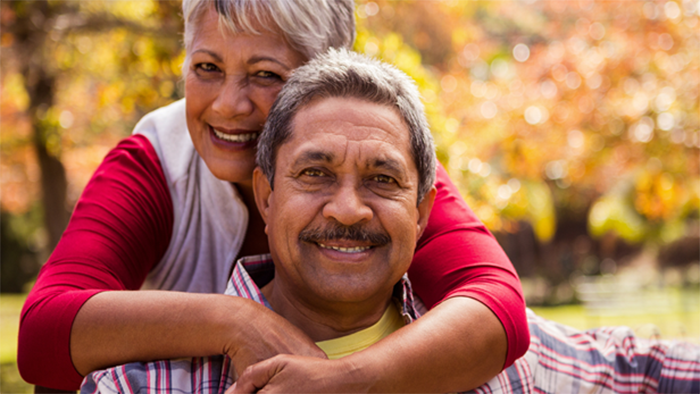
Falls can be prevented
Falls are a threat to the health of older adults and can reduce their ability to remain independent. However, falls don't have to be inevitable as you age. You can reduce your chance of falling or help a loved one prevent falls. There are proven ways to reduce and prevent falls, even for older adults. We identify older adults as anyone 65 years and older. CDC uses data and research to help prevent falls and save lives.
Take the Falls Free Checkup
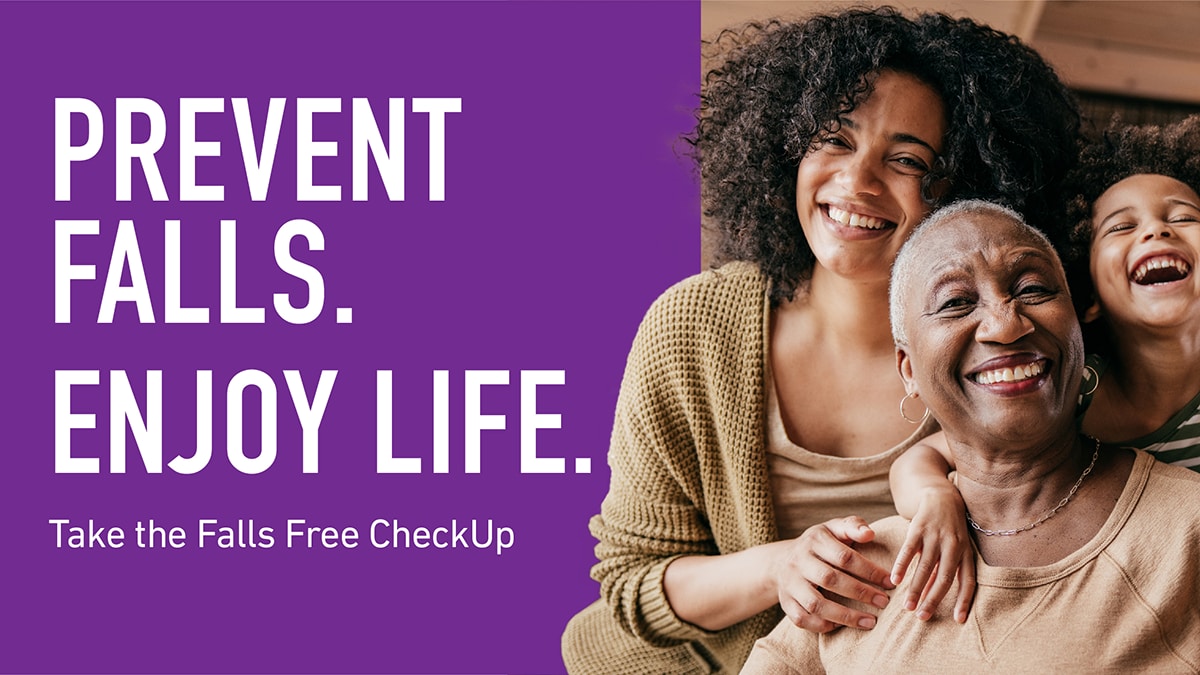
Take the Falls Free Checkup .
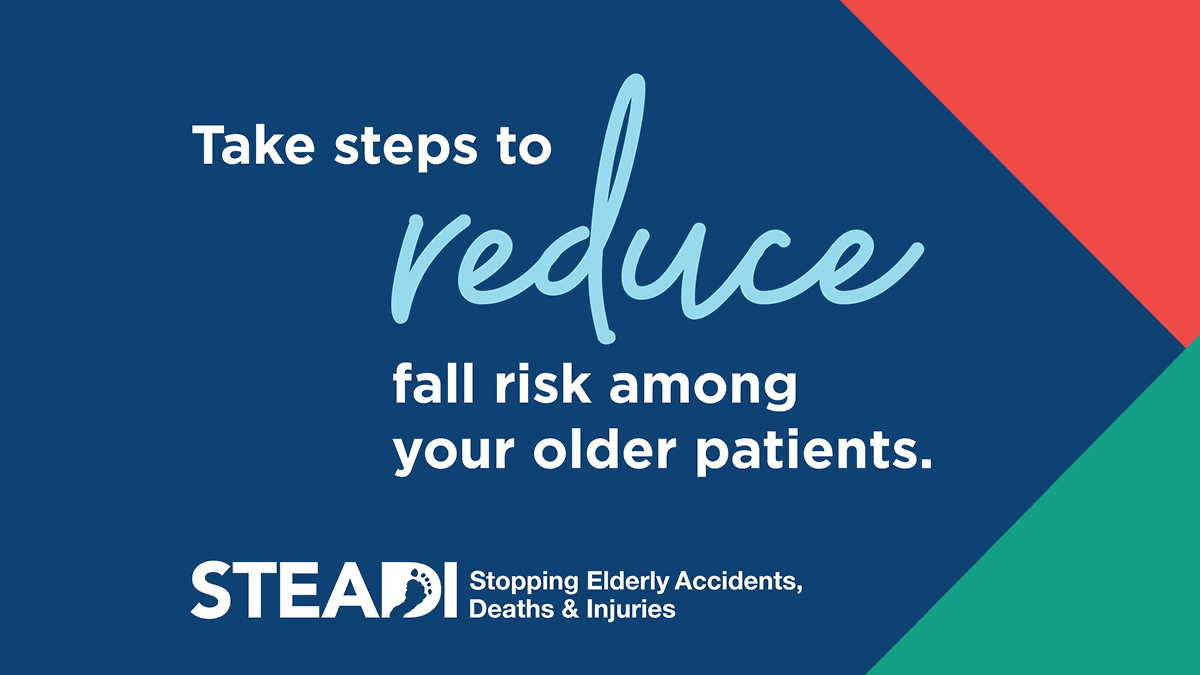
Health care providers are encouraged to visit the STEADI site to learn more about CDC's initiative to help reduce fall risk among your older patients.
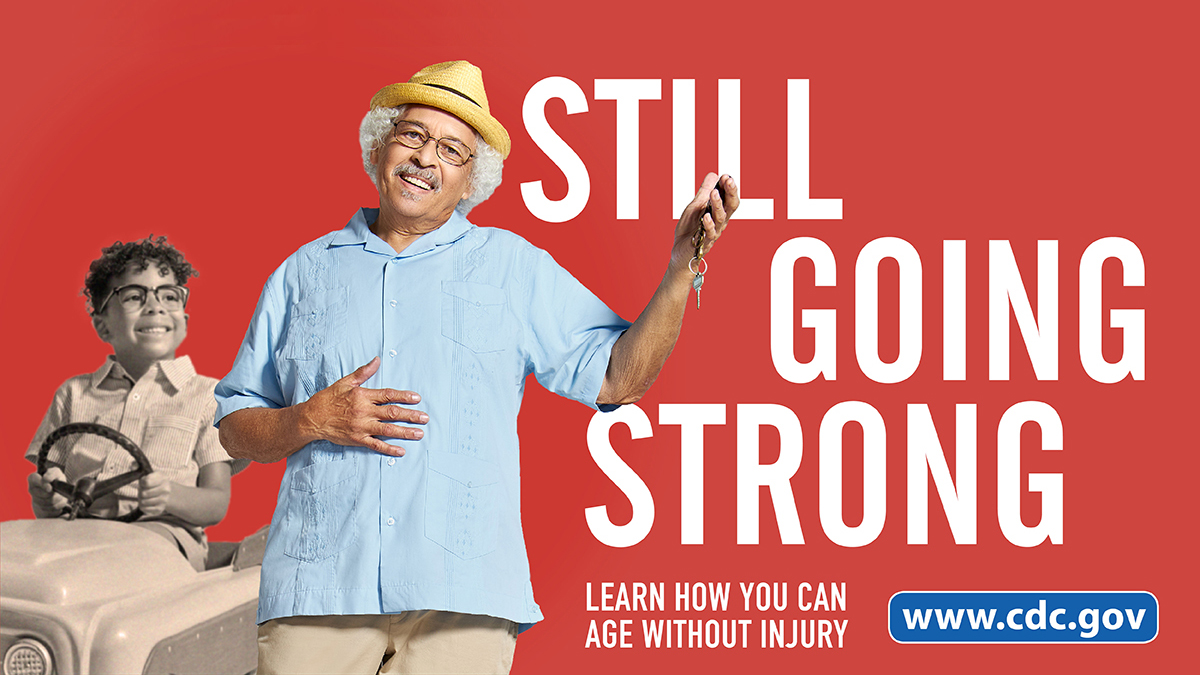
Visit the Still Going Strong site to learn how you can age without injury.
- MyMobility Plan ( English | Spanish | Tribal ) [8 pages]
- Medicines Risk: Are Your Medicines Increasing Your Risk of a Fall or Car Crash?
- Transportation Safety: Older Adult Drivers
- Concussions and Traumatic Brain Injury (TBI)
- About Abuse of Older Persons
- A Descriptive Analysis of Location of Older Adult Falls that Resulted in Emergency Department Visits in the U.S., 2015 ( American Journal of Lifestyle Living , August 2020)
- Trends in Nonfatal Falls and Fall-related Injuries Among Adults Aged ≥65 Years—U.S., 2012–2018 ( MMWR , July 2020)
- Fall-related Emergency Department Visits Involving Alcohol Among Older Adults ( Journal of Safety Research , June 2020)
- 1. Centers for Disease Control and Prevention, National Center for Injury Prevention and Control. Web–based Injury Statistics Query and Reporting System (WISQARS) [online].
- 2. Florence CS, Bergen G, Atherly A, Burns ER, Stevens JA, Drake C. Medical Costs of Fatal and Nonfatal Falls in Older Adults . Journal of the American Geriatrics Society. 2018 Apr;66(4):693–698. DOI:10.1111/jgs.15304.
Falls—and the injuries and deaths they cause—are increasing, but falls can be prevented. Learn more about Older Adult Fall Prevention.

Common Triggers of Slips, Trips, and Falls – And How To Avoid Them
Slips, trips, and falls are some of the most common causes of workplace injuries in the US, accounting for over 8 million emergency room treatments every year. While not all these incidents are severe, some will have serious consequences, such as bruises, strains, sprains, fractures, and head injuries.
In many cases, a slip or fall can make it difficult for you to move around, do everyday activities, or live as independently as you used to. It could even force you to take a few days or weeks off work, which will affect your income and productivity.
“Slips, trips, and falls can be frustrating, embarrassing, painful, and costly to you and your family. These accidents often leave victims hospitalized for days or weeks while the utility bills, medical bills, and other expenses collect at your doorstep,” says Alex Bouganim and Joseph Capetola, slip and fall lawyers in NYC .
What To Do If You Slip, Trip, Or Fall
Sometimes, no matter how careful you are, accidents can still happen, and it is crucial that you know what to do in this kind of situation so you can manage it in the best way possible. One of the first steps is to immediately seek medical attention, especially if the fall was quite hard and you are feeling pain anywhere in your body.
Injuries may not always be apparent, and a doctor can help determine specific problems and recommend the proper treatment. Aside from this, a trip to the doctor can help establish credibility if you decide to file a personal injury case or claim compensation against whoever was liable for the accident.
However, if you experience difficulty moving around, do not force yourself to get up right away and look for someone to help you instead. For severe trauma or injury, it is best to call an ambulance and stay in place until they arrive since any sudden movement could aggravate the damage to your body.
Finally, remember to report the incident to the property owner or manager or get someone to do it for you if you cannot move around freely, and make sure that there is proper documentation to help you establish evidence when you claim compensation. It is also a good idea to consult with a legal expert for specific guidance on what to do after a slip and fall accident since the actual steps to do may vary depending on the location and circumstances of the accident.
Common Causes And How To Avoid Them
Awareness is vital in preventing you from becoming a victim of these accidents. When you know the causes of slips, trips, and falls, it becomes easier to avoid them and you can even prevent them from happening to others. Take a look at these common triggers of slips, trips, and falls and what you can do about them:
1. Poor Lighting
Poor lighting can make it difficult to see hazards and other dangers, such as stairs, curbs, or wet and slippery surfaces, increasing your risk of slipping or falling. If you have poor vision, this is even more of a problem because the dim and dark surroundings can hide any obstructions in your path and prevent you from taking evasive action to avoid getting tripped.
To prevent slip and fall accidents due to poor lighting, ensure that all walkways are well-lit, especially in areas with high foot traffic or potential hazards. Install adequate lighting sources, such as overhead lighting or task lighting in darker areas, and immediately replace light bulbs when they burn out.
2. Slippery Or Uneven Surfaces
One of the most common triggers of slips, trips, and falls are slippery or uneven surfaces because they can cause you to lose your footing easily. These are often caused by ice, snow, water, oil or grease, sand, mud or dirt, loose gravels or stones, and man-made causes like waxed floors, which could become slippery due to spills or leaks.
Fortunately, there are many ways you can avoid falling victim to these triggers, and wearing proper footwear is at the top of the list. Shoes with good traction and non-slip soles can help prevent slips and falls, while smooth or worn-out soles can increase your risk. Take extra precautions by immediately cleaning up any spills or wet areas, using non-slip mats in areas prone to getting wet, such as bathrooms or kitchens, and being careful when walking on freshly cleaned or waxed floors.
3. Mats And Rugs
When not correctly displayed or maintained, mats and rugs can result in a slip or trip, especially for an unsuspecting passerby. For example, curled-up edges or lumps in the middle of a rug could entangle your feet and cause you to lose your balance. It is also highly possible for a loose and unsecured rug to slip out of place right when you step on it, leading to a nasty fall and an injury.
To prevent rugs and mats from becoming a tripping hazard, ensure they are properly secured and maintained. Regularly inspect them for signs of wear and tear, and immediately replace any rugs that are frayed, have holes, or are lumped in certain parts. Keep them completely flat, with no bumps or curls on the edges, and use non-slip pads underneath so they stay firmly in place.
4. Excessive Clutter
Aside from being a tripping hazard, clutter can also cause fires, which is why it is essential to do regular housekeeping to prevent these incidents from occurring. Excessive clutter like books, shoes, toys, cords, loose rugs, and stacks of newspapers on the floor create environmental hazards that impede movement and result in blockages that hinder people from walking safely.
You can minimize the occurrence of these incidents by making sure that all walkways, hallways, and stairways are always clear of clutter. Keep your space organized, secure loose cords, and use storage solutions such as shelves, cabinets, or drawers to keep items off the floors and tables.
5. Uneven Or Poorly Built Stairs
Stairs that are damaged or not built according to safety standards can lead to serious injuries, especially if you fall from a higher level. This includes stairways with no handrails covered in dirt and debris or have broken, loose, uneven, or missing steps. Aside from these, obstructions like boxes or clutter on the steps can also cause people to trip and fall.
You can reduce the risk of slipping firstly by ensuring that your stairs are built according to strict guidelines , with the stair slope maximum range being from 30 to 50 degrees. As an additional preventive measure, you can install non-slip surfaces on the stairs, such as rubber or slip-resistant paint, and ensure that stairways are well-lit and have a clear path by removing any items left on the steps like shoes or work equipment that can create potential hazards. Carpeted stairs should also be in good condition with no noticeable deterioration, excessive wear, or missing treads.
The post Common Triggers of Slips, Trips, and Falls – And How To Avoid Them appeared first on What's Trending .

National Safety Month 2024
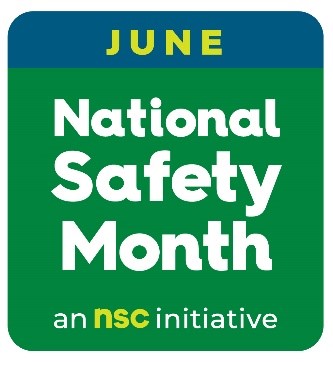
Please download and share the free safety materials from NSC including a poster, social media kit , animated graphics, 5-minute safety talks, games, articles and more – plus NSC members get additional exclusive resources. Visit the NIOSH website , eNews , blog , and social media accounts to stay safe this month and all year long.
Week 1: Safety Engagement
Both employers and employees must be engaged in safety. Working together, employers and employees can develop policies and procedures to identify, monitor, mitigate, and eliminate work-related hazards. The NIOSH Total Worker Health ® workbook, Fundamentals of Total Worker Health Approaches: Essential Elements for Advancing Worker Safety, Health, and Well-Being can help workplaces:
- Provide a baseline of where an organization is on the path to worker well-being.
- Identify initial steps to improve workforce safety, health, and well-being.
- Measure an organization’s progress.
The Small Business Handbook provides small business employers with workplace safety and health information. The handbook summarizes the benefits of an effective safety and health program, provides self-inspection checklists for employers to identify workplace hazards, and reviews key workplace safety and health resources for small businesses.
NIOSH provides multiple trainings, tools, and activities to encourage employee and employer engagement in safety.
When it comes to safety engagement , communication is key at all levels of an organization. Safety+Health ® magazine, the flagship publication of the National Safety Council, provides helpful articles to address this important topic including:
- Harness Team Spirit to Energize Safety
- Difficult Conversations: Simple Steps to Make Them Easier
- The Power of Influence
The magazine also includes a My Story section as well as an On the Safe Side podcast series . The Council’s Safety is Personal video series shares the stories of leaders including what sparked their passion for safety, and how they live out the mission of saving lives in their workplaces every day.
Part of communicating the importance of safety is also knowing and sharing the statistics and research – the why people should care about safety. The Council’s Injury Facts® website is a wealth of information. Learn more by attending a free June 5 webinar Injury Facts : Data You Can Count On . Also, check out white papers from the NSC research team.
Taking part in activities and training are also essential to building engagement around safety. The Council encourages all workers to take the SafeAtWork pledge to show their commitment to safety. NSC offers a variety of training opportunities and events , including a new free eLearning course on Naloxone for Suspected Opioid Overdose . The more touchpoints we have with workers in all positions, the greater impact can be made in improving safety engagement.
Week 2: Roadway Safety
Motor vehicle crashes are the leading cause of work-related deaths in the United States and the 1st or 2nd leading cause of death in every major industry group. [1] The NIOSH Center for Motor Vehicle Safety conducts research and develops strategies to prevent work-related motor vehicle crashes and resulting injuries. Driver fatigue is a major workplace safety risk. The good news: a fatigue risk management system can help employers and workers reduce the risks of driver fatigue. Learn more about preventing driver fatigue on the Driver Fatigue on the Job website.
Forty-four percent of the occupational fatalities at road construction sites involved a worker struck-by a vehicle in a work zone. [2] Struck-by injuries are the leading cause of nonfatal injuries and second most common cause of fatalities among construction workers. From 2011 to 2022, there were 1,462 fatal occupational injuries that occurred at road construction sites . 2 The 2024 National Safety Stand-Down to Prevent Struck-by Incidents highlighted the use of Internal Traffic Control Plans to help protect workers in roadway work zones. Motor vehicle-related incidents are also a leading cause of line-of-duty deaths for law enforcement officers in the United States. [3] In the last 10 years, on average, one officer per week has been killed on our nation’s roads. 3 These deaths and injuries are preventable. The NIOSH Law Enforcement Motor Vehicle Safety website offers resources and prevention strategies for all motor vehicle-related incidents including the Officer Road Code Toolkit .
NSC estimates 44,450 people died in motor vehicle crashes in 2023. With crashes being the leading cause of workplace death, the choices we make behind the wheel can improve roadway safety for us all. NSC encourages drivers to share the road responsibly by following these safety tips:
- Prepare before you go: Vehicle owners should check the oil, put air in the tires, and check for and repair open recalls to make sure their vehicles are safe for driving
- Buckle up: Lack of seat belt use is a top cause of fatalities in crashes – buckle up, while also making sure you have appropriate car seats installed correctly
- Designate a sober driver or arrange alternate transportation: Alcohol is only one cause of impaired driving – drugs, including opioids, cannabis and some over-the-counter medicines, can cause drowsiness, alter visual functions, and affect mental judgment and motor skills
- Slow down: Speeding is a factor in more than a quarter of all traffic fatalities – drive the speed limit or below it if conditions dictate
- Drive distraction-free: Thousands have died in car crashes involving cell phone use – put your phones away and #JustDrive
- Look before you lock: Pediatric vehicular heatstroke is still the leading cause of non-crash motor vehicle-related fatality for children – always check your back seat for children or animals when you reach your destination, especially as approximately 25% of these deaths have occurred at the parent or caregiver’s place of work
- Demand safer roads and safer speeds: Join the Road to Zero Coalition to learn about the Safe System approach on road safety
Some employers may not be aware they have a fleet and need to follow the proper safety protocols. Unfortunately, not all fleet drivers are well-trained. Any worker who drives for work should be considered a fleet driver. Check out this webinar on the Top Three Things to Know When Managing a Fleet .
Week 3 Risk Reduction

One of the best ways to prevent and control occupational injuries, illnesses, and fatalities is to “design out” or minimize hazards and risks. NIOSH leads a national initiative called Prevention through Design (PtD) whose purpose is to promote this concept and highlight its importance in all business decisions.
Exposure assessment plays a central role in risk management. NIOSH’s Exposure Assessment Program provides national and international leadership in the development and use of effective exposure assessment strategies and tools to prevent work-related illness and injury.
According to Injury Facts , in 2022, preventable work deaths totaled 4,695, and workplace medically consulted injuries totaled 4.53 million underscoring the importance of risk reduction . Tried and true injury prevention approaches like hazard recognition, job safety analysis and risk assessment are crucial to curbing workplace injuries and deaths.
Further, understanding the value of workplace safety and health is too often an exercise in waiting until an incident – or even a tragedy – occurs. Yet the value of safety is an increasingly multi-dimensional concept due to changing trends and dynamics well beyond physical risk. Check out the Council’s research on the New Value of Safety: From ESG to the Whole Person , which highlights three organizational concepts that generate a broad value and drive a holistic approach to safety management for highly embedded and emerging risks, including:
- Human and Organizational Performance (HOP)
- Optimizing work design and improving working conditions
- Safeguarding and advancing the mental health of workers
- Preventing injury and fatality
- Addressing psychological safety
- Environment, Social and Governance (ESG), which covers several initiatives shaping modern safety excellence, including diversity, equity and inclusion (DEI)
The Council also offers several programs and initiatives addressing top occupation safety risks, including:
- MSD Solutions Lab
- Respond Ready Workplace
- Campbell Institute
- Work to Zero
Check out these programs for free resources and research to help reduce risk in your organization.
Week 4: Slips, Trips and Falls
Falls are a hazard found in most work sectors. NIOSH has many fall prevention resources on its website including the ladder safety app , the mast climbing work platform inspection tool , and the mining Infographic: Don’t Slip Up! In 2022, falls from elevation represented approximately 81% of all fatal and 20% of all nonfatal slips, trips, and falls for all industry workers. [4] [5] Many of these falls occurred in the construction industry. In fact, construction workers made up nearly half (49%) of all fatal occupational slips, trips, and falls. 5 Since 2013, construction workers have suffered approximately 300 fatal and 20,000 nonfatal fall-related injuries per year. [6] The National Safety Stand-Down , part of the National Campaign to Prevent Falls in Construction , raises awareness that falls among construction workers are preventable. Read more on the blog .
The highest numbers of nonfatal fall injuries are in the health services and the wholesale and retail sectors. NIOSH research found that providing highly-rated slip-resistant shoes to food service workers led to a 67% reduction in workers compensation claims for slip injuries. Download the infographic available in English and Spanish. Slips, trips, and falls are also the most common cause of injury for workers in elementary and secondary schools . Visit the NIOSH falls website to learn how to keep workers safe.
Slips, trips and falls are a leading cause of workplace injury and death, and although a persistent challenge, they must remain top of mind. NSC provides statistics on workplace falls both to a lower level and on the same level as well as older adult falls to help show the scope of the problem. The Council also provides a Falls from Heights Toolkit , which provides best practices, planning tools, fact sheets, posters and more.
The Council’s Safety+Health magazine shares a variety of articles addressing this topic including:
- 7 Tips for Safe Use of Ladders
- 5 Facts for Safe Use of Aerial Lifts
- Reducing Slips, Trips and Falls
- Think You Know Ladder Safety? Quiz
The Work to Zero initiative at NSC believes safety technology can play an important role in preventing falls. Check out technologies for addressing the hazardous situation of Work at Height .
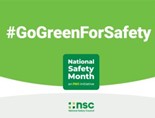
John Howard, MD, is the Director of the National Institute for Occupational Safety and Health.
Lorraine M. Martin is the President & CEO of the National Safety Council.
This is also posted on the National Safety Council blog .
[1] Bureau of Labor Statistics, 2018
[2] Bureau of Labor Statistics (BLS) [2024]. Census of Fatal Occupational Injuries (2011 Forward) Database. https://www.bls.gov/iif/data.htm .
[3] National Law Enforcement Officers Memorial Fund [2021]. Causes of law enforcement deaths
[4] Bureau of Labor Statistics (2023). News Release National Census of Fatal Occupational Injuries in 2022. USDL-23-2615. December 19, 2023. Available from: https://www.bls.gov/news.release/pdf/cfoi.pdf .
[5] Bureau of Labor Statistics (2023). Number of nonfatal occupational injuries and illnesses involving days away from work, restricted activity, or job transfer (DART), days away from work (DAFW), and days of restricted work activity, or job transfer (DJTR) by event or exposure leading to injury or illness and industry sector, private industry, 2021-2022 (TABLE R64). November 8, 2023. Available from: https://www.bls.gov/iif/nonfatal-injuries-and-illnesses-tables/case-and-demographic-characteristics-table-r64-2021-2022.xlsx
[6] CPWR (2024). Data Bulletin: Fatal and Nonfatal Falls in the US Construction Industry. The Center for Construction Research and Training. Silver Spring, MD. March 2024. https://www.cpwr.com/wp-content/uploads/DataBulletin-March2024.pdf.
Post a Comment
Cancel reply.
Your email address will not be published. Required fields are marked *
- 50th Anniversary Blog Series
- Additive Manufacturing
- Aging Workers
- Agriculture
- Animal/Livestock hazards
- Artificial Intelligence
- Back Injury
- Bloodborne pathogens
- Cardiovascular Disease
- cold stress
- commercial fishing
- Communication
- Construction
- Cross Cultural Communication
- Dermal Exposure
- Education and Research Centers
- Electrical Safety
- Emergency Response/Public Sector
- Engineering Control
- Environment/Green Jobs
- Epidemiology
- Fire Fighting
- Food Service
- Future of Work and OSH
- Healthy Work Design
- Hearing Loss
- Heat Stress
- Holiday Themes
- Hydraulic Fracturing
- Infectious Disease Resources
- International
- Landscaping
- Law Enforcement
- Manufacturing
- Manufacturing Mondays Series
- Mental Health
- Motor Vehicle Safety
- Musculoskeletal Disorders
- Nanotechnology
- National Occupational Research Agenda
- Needlestick Prevention
- NIOSH-funded Research
- Nonstandard Work Arrangements
- Observances
- Occupational Health Equity
- Oil and Gas
- Outdoor Work
- Partnership
- Personal Protective Equipment
- Physical activity
- Policy and Programs
- Prevention Through Design
- Prioritizing Research
- Reproductive Health
- Research to practice r2p
- Researcher Spotlights
- Respirators
- Respiratory Health
- Risk Assessment
- Safety and Health Data
- Service Sector
- Small Business
- Social Determinants of Health
- Spanish translations
- Sports and Entertainment
- Strategic Foresight
- Struck-by injuries
- Student Training
- Substance Use Disorder
- Surveillance
- Synthetic Biology
- Systematic review
- Take Home Exposures
- Teachers/School Workers
- Temporary/Contingent Workers
- Total Worker Health
- Translations (other than Spanish)
- Transportation
- Uncategorized
- Veterinarians
- Wearable Technologies
- Wholesale and Retail Trade
- Work Schedules
- Workers' Compensation
- Workplace Medical Mystery
- Workplace Supported Recovery
- World Trade Center Health Program
- Young Workers
To receive email updates about this page, enter your email address:
Exit Notification / Disclaimer Policy
- The Centers for Disease Control and Prevention (CDC) cannot attest to the accuracy of a non-federal website.
- Linking to a non-federal website does not constitute an endorsement by CDC or any of its employees of the sponsors or the information and products presented on the website.
- You will be subject to the destination website's privacy policy when you follow the link.
- CDC is not responsible for Section 508 compliance (accessibility) on other federal or private website.
- Privacy Policy
Entrepreneurship Life
- Productivity
- June 6, 2024
Top 10 Biggest Causes of Workplace Accidents and What You Can Do About It

In the year 2022/23, a staggering 561,000 workers in the UK sustained non-fatal injuries in their workplaces, and 124,000 of these injuries resulted in absences exceeding seven days.
While accidents are an unfortunate reality, many of these work-related injuries could have been prevented through proper measures.
Reducing the occurrence of accidents ensures employee safety and maintains productivity levels. What makes this even easier is that implementing preventive measures has become more accessible than ever before.
Before we look at what your business can do to prevent these injuries, let’s see what the 10 biggest causes of workplace accidents are, so you can identify what is common in your particular workplace and how to mitigate it.
Table of Contents
1.Slips, Trips, and Falls
32% of all non-fatal workplace injuries were attributed to slips, trips, and falls, making them the most common type of accident. They can happen in any workplace setting where employees may encounter slippery surfaces, which can result from spills, oil leaks, and debris. Working from ladders, scaffolding, or high platforms is another way employees can expose themselves to dangerous situations and heighten the risk of falls.
2.Handling, Lifting, or Carrying
Lifting heavy objects at work can lead to severe injuries like back problems, broken bones, muscle strains, and even heart issues. While often associated with warehouses, improper handling, lifting, or carrying techniques can cause injuries in any workplace setting.
3.Falling Objects
Objects falling from heights can lead to painful injuries, even if they are not particularly heavy. A light object can still cause damage if it falls with enough momentum from a significant height. Improper storage and unsecured placement of objects on shelves or cupboards can cause significant injuries. A common issue is employees storing heavier items in the top drawers of filing cabinets to avoid bending down, making the cabinets top-heavy and prone to toppling over.
4.Toxic Fumes
These fumes can arise from hazardous chemicals in laboratory or manufacturing environments. Exposure to them can cause skin or eye reactions and even respiratory problems in the long term.
5.Repetitive Strain
Repetitive strain injury (RSI) is commonly associated with office workers who perform repetitive movements, such as typing, but it can affect various professions like hairdressers and assembly line workers. RSI is an umbrella term for painful conditions that develop gradually, often causing symptoms like stiffness, weakness, swelling, and more that can become severe if left unaddressed.
Hazardous chemicals can also lead to chemical burns, but there are many other types of potential burns in the workplace, including heat burns and electrical burns.
Burns result in damage to your body’s skin tissue and, while many are minor, some burns can result in life-changing consequences.
Cuts and lacerations can occur in various environments. Improper use or lack of safety equipment when handling equipment like knives or paper trimmers can lead to these injuries. Many are minor, but there is always a risk of more severe cuts.
8.Exposure to Loud Noises
Loud noise exposure is a significant risk for industrial workers. While the effects may not be immediately noticeable, prolonged exposure to excessive noise levels can lead to irreversible hearing damage Overlooking the need for proper ear protection can have long-term consequences.
9.Vehicle Collisions
Driving is a crucial part of many jobs, including delivery drivers and forklift operators. Operating vehicles on the job can pose risks of collisions and accidents, potentially leading to devastating injuries, which are more common when workers are fatigued or distracted while driving.
10.Acts of Violence
With different kinds of people in the workplace, tensions between colleagues can arise, which can lead to a verbal or physical fight that can lead to injuries.
What Can You Do About These Issues?
- Here are some of the top preventive methods to reinforce in the workplace:
- Provide safety equipment such as protective goggles and ear protection
- Enforce safe operating procedures
- Safety procedure training, such as manual handling training and how to act if a burn was to arise
- Clear signage, such as warning labels on hazardous chemicals or wet floor signs
- Regular break reminders for employees
- Grievance procedures to minimise the risk of employee tensions escalating
Regular Risk Assessments to Identify Changing Risks
Of course, there’s much more that can be done to prevent workplace accidents but these are a few things to begin making your workplace a better place to work.
Related posts you might like:
- Five Common Workplace Accidents and How to Avoid Them
- Safety Tips When Using Household Cleaning Chemicals
- Different Types of Retail Injuries and Why Should You Have Workers’ Comp
- Are Workplace Accidents Still Something to Be Concerned About?

Entrepreneur Series
- Becoming an Entrepreneurial Writer
- Cloud Accounting Reviews
- Entrepreneur Profiles
- Interview with John Mattone
Return to top of page
Copyright © 2024 · Privacy Policy
This Website Uses Cookies: By using this website without changing the cookie settings in your web browser you consent to all cookies in the Cookie Policy .
Las Vegas, NV
March 3-7, 2026

Building a Safer Future: National Safety Month 2024
As we usher in the summer of 2024, the construction industry once again prepares to participate in National Safety Month , an annual observance aimed at raising awareness about workplace safety. Organized by the National Safety Council (NSC) , National Safety Month is celebrated every June to highlight critical safety issues and promote best practices that can prevent injuries and save lives. For construction contractors, this month provides an opportunity to reinforce the importance of safety protocols and foster a culture that prioritizes the well-being of all workers.
THE SIGNIFICANCE OF NATIONAL SAFETY MONTH
The construction industry is inherently risky, with workers frequently exposed to hazards such as falls, electrical shocks, heavy machinery and hazardous materials. One in five worker deaths in the United States occurs in construction. This stark statistic underscores the urgent need for ongoing safety education and improvements within the industry.
National Safety Month serves as a dedicated period for construction contractors to review their safety programs, conduct training sessions and engage employees in conversations about safety. By doing so, contractors can help reduce the number of accidents and injuries on jobsites, creating a safer work environment for everyone.
WEEK-BY-WEEK FOCUS AREAS
National Safety Month 2024 will cover a variety of topics, each crucial for enhancing safety awareness and practices on construction sites. Here’s a breakdown of the focus areas for each week and how constructors can use these to enhance safety operations.
Week 1 (June 1-8): Safety Engagement
Creating a culture of safety within the workplace is essential for the success of any safety program. This week can focus on enhancing active participation and awareness among employees through several key strategies. First, implement interactive training sessions that utilize engaging learning methods and simulations to make safety education more captivating. Second, establish safety committees composed of representatives from various departments to promote a collective safety culture. Third, maintain robust communication campaigns by regularly sharing safety tips and success stories with your entire workforce.
Week 2 (June 9-15): Roadway Safety
Ensuring roadway safety is vital for organizations with employees who drive as part of their jobs. This week can highlight best practices to minimize accidents on the road. Start by offering defensive driving courses that train drivers to anticipate and respond to potential hazards. Regular vehicle maintenance is also essential—implement consistent inspection and maintenance schedules to ensure all vehicles are roadworthy. Additionally, develop clear driving policies, including mandatory seat belt use, adherence to speed limits and the prohibition of mobile phone use while driving.
This month provides an opportunity to reinforce the importance of safety protocols and foster a culture that prioritizes the well-being of all workers.
Week 3 (June 16-22): Risk Reduction
Proactively addressing potential hazards is key to preventing workplace injuries. This week can focus on effective risk reduction strategies. Begin with regular risk assessments to identify and prioritize mitigation efforts for potential hazards. Ensure robust hazard communication so all employees are aware of the risks in their work environment and understand how to mitigate them. Additionally, develop and routinely update emergency preparedness plans, including clear evacuation procedures and comprehensive first aid training.
Week 4 (June 23-30): Slips, Trips and Falls
Slips, trips and falls are among the most common workplace injuries, yet they can be significantly reduced with the right preventative measures. This week can emphasize key strategies to tackle these hazards. Begin with thorough evaluation and control by identifying and assessing risks, followed by training employees in prevention techniques. Encourage the use of proper personal protective equipment (PPE), such as hard hats, safety glasses and fall protection gear, to mitigate injury risks. Lastly, conduct regular safety inspections to identify and rectify potential slip, trip and fall hazards.
HOW CONTRACTORS CAN GET INVOLVED
- Conduct Safety Training Use National Safety Month as an opportunity to conduct comprehensive safety training sessions. Cover the focus areas for each week and ensure that all employees understand the importance of following safety protocols.
- Review and Update Safety Plans Take the time to review and update your safety plans, ensuring that they reflect current best practices and address any new hazards that may have emerged.
- Engage Employees Encourage employees to actively participate in safety initiatives. Hold safety meetings, encourage reporting of hazards and recognize workers who demonstrate a commitment to safety.
- Promote Mental Health Resources Provide resources and support for mental health , such as access to counseling services, stress management programs and mental health first aid training.
- Celebrate Successes Acknowledge and celebrate safety successes, whether it’s completing a project without any incidents or recognizing an employee for their dedication to safety. Celebrating these achievements can reinforce the importance of safety and motivate everyone to maintain high standards.
LOOKING AHEAD
National Safety Month 2024 presents a valuable opportunity for construction contractors to enhance their safety programs, protect their workers and build a culture of safety. By participating in each of the four focus areas in June, contractors can help create safer jobsites all year long.
Remember, safety is not a one-time event but an ongoing commitment. Use National Safety Month as a springboard to continuously improve safety practices and ensure that every worker returns home safely at the end of the day. Together, we can all build a safer future for the construction industry.
FREE SAFETY RESOURCES
Access free materials on the NSC website without needing membership. Simply enter some basic information for immediate access to safety month planning resources: Posters, Safety Signs, SafeAtWork Pledge, Weekly Safety Talks and Games, and much more!
Photo credit: KUZMA/BIGSTOCKPHOTO.COM
Business Management
Subscribe to the CONEXPO-CON/AGG 365 weekly newsletter to receive more great stories like this.
Related Articles

Construction Industry Faces Challenges and Opportunities in Second Half of 2024
As we move into the second half of 2024, the construction industry faces a dynamic economic landscape filled with both challenges and opportunities. From fluctuating material...

Navigating the Entrepreneurial Abyss: Insights from 3rd Generation Business Owners with John Scepaniak
Director of Aggregate Operations at Wm. D. Scepaniak, Inc., and fellow third-generation entrepreneur, John Scepaniak joins Taylor White of Ken White Construction on the podcast...

How to Start Using AI in Construction Marketing
The idea of integrating artificial intelligence (AI) into your construction marketing strategy might seem daunting. But those who ignore this emerging technology will be left...

Saving Through Sustainability: 5 Ways Contractors Can Cut Costs
If crushed glass is tough enough for one of the nation’s busiest highways, then it’s good enough for an array of projects, and that ability to turn trash into viable...

How to Build A Successful Safety Leadership Training Program
Safety is central in every aspect of the construction industry. Implementing a robust safety leadership training program is essential for any construction firm aiming to enhance...

20 Tips from Veteran CONEXPO-CON/AGG Attendees

10 Best States for Construction Jobs

Five Equipment Dealership Trends That Will Shape 2023

7 Innovative Construction Materials to Watch for in 2024
An official website of the United States government
The .gov means it’s official. Federal government websites often end in .gov or .mil. Before sharing sensitive information, make sure you’re on a federal government site.
The site is secure. The https:// ensures that you are connecting to the official website and that any information you provide is encrypted and transmitted securely.
- Publications
- Account settings
Preview improvements coming to the PMC website in October 2024. Learn More or Try it out now .
- Advanced Search
- Journal List
- Front Public Health
- PMC10344358
Factors associated with falls among hospitalized and community-dwelling older adults: the APPCARE study
Esmée l. s. bally.
1 Department of Public Health, Erasmus MC University Medical Center, Rotterdam, Netherlands
Amy van Grieken
Siok swan tan.
2 Research Group City Dynamics, InHolland University of Applied Sciences, Rotterdam, Netherlands
Francesco Mattace-Raso
3 Division of Geriatric Medicine, Erasmus MC University Medical Center, Rotterdam, Netherlands
Elena Procaccini
4 Funded Project Office, Local Health Authority n.2 Treviso, Treviso, Italy
Tamara Alhambra-Borrás
5 Polibienestar Research Institute, University of Valencia, Valencia, Spain
Associated Data
The datasets presented in this article are not readily available because requests from third parties need to be reviewed first. Requests to access the datasets should be directed to [email protected] .
Falls are a leading cause of disability. Previous studies have identified various risk factors for falls. However, contemporary novel research is needed to explore these and other factors associated with falls among a diverse older adult population. This study aims to identify the factors associated with falls among hospitalized and community-dwelling older adults.
Cross-sectional data from the ‘Appropriate care paths for frail elderly people: a comprehensive model’ (APPCARE) study were analyzed. The study sample consisted of hospitalized and community-dwelling older adults. Falling was assessed by asking whether the participant had fallen within the last 12 months. Multivariable logistic regression models were used to evaluate associations between socio-demographic characteristics, potential fall risk factors and falls.
The sample included 113 hospitalized (mean age = 84.2 years; 58% female) and 777 community-dwelling (mean age = 77.8 years; 49% female) older adults. Among hospitalized older adults, loneliness was associated with an increased risk of falls. Associations between female sex, secondary education lever or lower, multimorbidity, a higher score on limitations with activities of daily living (ADL), high risk of malnutrition and falling were found among community-dwelling participants.
The results of this study confirm the multi-factorial nature of falling and the complex interaction of risk factors. Future fall prevention programs could be tailored to the needs of vulnerable subpopulations at high risk for falls.
1. Introduction
A fall can be defined as “an unexpected event in which the participant comes to rest on the ground, floor, or lower level” ( 1 ). One in three community-dwelling older adults fall each year ( 2 ), and the incidence rate of fall-related injuries increases with age ( 3 ). After a fall, 20 to 30% of older adults have moderate to severe injuries ( 1 ). In approximately 10% of all cases falls can lead to serious injuries that require hospitalization, such as fractures, joint dislocations, and head injury ( 2 ). Falling affects not only the health of older adults, but also places a high burden on public health resources ( 4 ). In 2021, in the Netherlands, the estimated direct medical costs were 1.5 billion euros ( 5 ) which is expected to increase to 2.7 billion by 2040 as the population ages ( 6 ).
Falls can have multiple causes resulting from the complex interaction of risk factors. Previous studies have identified several predicting factors for falls in the general population, including socio-demographic (e.g., age, sex), biological (e.g., history of falls, visual impairment), environmental (e.g., home hazards, physical disability), behavioral (e.g., medication intake, sedentary behavior) and cognitive-related factors ( 7–10 ). Among community-dwelling older adults, previous studies identified older age (7-10), being female (7, 10), the presence of multiple health conditions ( 9 ), being frail ( 7 ), having mobility limitations ( 8–10 ) using multiple medications ( 7 , 9 ) and having depressive symptoms ( 7 , 8 ) as the predictors most strongly associated with falls.
However, differences may exist between hospitalized and community-dwelling older adults. Identifying the factors associated with falls among subpopulations is crucial in fall prevention ( 11 ). It enables the identification of older adults who are at high risk of falling, thereby allowing tailored fall prevention programs for various groups at risk. The aim of the current study is to identify the factors associated with falls among hospitalized and community-dwelling older adults. The factors included in the study are socio-demographic characteristics and potential fall risk factors (e.g., health indicators, lifestyle factors).
2.1. Study design
A cross-sectional study was performed using data from the ‘Appropriate care paths for frail elderly people: a comprehensive model’ (APPCARE) study. APPCARE is a prospective cohort study funded by the European Commission, under Grant Agreement No. 664689. APPCARE aimed to promote healthy aging. The project has been conducted in three European sites (Rotterdam, the Netherlands; Treviso, Italy, and; Valencia, Spain). The current study used baseline data from the Rotterdam site.
2.2. Participants
The study sample consisted of hospitalized and community-dwelling older adults. Three hospitals located in the Rotterdam region contributed to the recruitment of hospitalized older adults. All patients ≥70 years and older that entered the geriatric ward were invited by their healthcare provider to participate in the study, resulting in a total of 137 invited patients. Additionally, in collaboration with the Municipality of Rotterdam, 865 community-dwelling older adults (≥65 years) were invited by letter. An information package with an information sheet, informed consent form, baseline questionnaire, and prepaid envelope was distributed by post. Data were collected between 2017 and 2018. Participants who provided informed consent and completed the baseline questionnaire were included in the study. The Medical Ethics Committee of Erasmus MC University Medical Center in Rotterdam declared that the rules laid down in the Medical Research Involving Human Subjects Act (also known by its Dutch abbreviation WMO), do not apply to this research (reference number: MEC-2016-559).
Data from 966 participants who provided informed consent and filled in the baseline questionnaire were available for this study. In order to conduct the full analysis, participants with missing data in the outcome variable ( n = 35), age ( n = 39), and sex ( n = 2) were excluded, resulting in 890 (92.1%) subjects included. A flow diagram of the population of analysis is presented in Figure 1 .

Population of analysis.
2.3. Measures
2.3.1. falling.
The outcome measure used in this study is rate of falling. Falls were self-reported and assessed by asking participants “Have you had a fall in the last 12 months?” ( 12 ). Fall status was dichotomized into has fallen one or more times versus no falls.
2.3.2. Socio-demographic factors
Socio-demographic characteristics were assessed at baseline and included as covariates. Age (in years) was provided by participants and categorized into 65–79 years and ≥ 80 years for logistic regression. This cut-off was chosen based on publications by the World Health Organization, in which the oldest-old is defined as people aged 80 or older ( 2 , 13 ). Living situation was categorized into living with others or living alone. Education level concerned the highest level of education the participant achieved and was split into two categories based on the International Standard Classification of Education (ISCED). ISCED level 0–5 was categorized as ‘secondary or lower’ and ISCED level 6–8 was categorized as ‘tertiary or higher’ ( 14 ).
2.3.3. Fall risk factors
Variables reported as risk factors in the literature ( 15 , 16 ) and assessed at baseline were considered as associated factors: multimorbidity, frailty, limitations with activities of daily living (ADL), loneliness, risk of medication-related problems, risk of malnutrition, physical activity and poor vision. Multimorbidity was defined as having two or more medical conditions and/or disabilities at the same time ( 17 ). Participants were asked whether they had one or more chronic conditions diagnosed by a medical professional. A list of 13 common chronic conditions (e.g., high blood pressure, stroke, diabetes) was provided to participants to select from ( 18 ). Participants could add any health condition that was not listed. Frailty was assessed by the 15-item Tilburg Frailty Indicator (TFI) ( 19 ). The score on overall frailty ranged from 0 to 15. Participants with a total TFI-score ≥ 5 were considered frail ( 19 ). ADL limitations were measured with the Groningen Activity Restriction Scale (GARS) ( 20 ). Response categories by activities were: ‘Yes, I can do this fully independently, without any difficulty’, ‘Yes, I can do this fully independently, but with some difficulty’, ‘Yes, I can do this fully independently, but with great difficulty’, and ‘No, I can only do it with someone’s help’. Answers were assessed on a 4-point scale with a minimum score of 18 and maximum score of 72. Higher scores represented a lower level of independence. Loneliness was measured using the 6-item De Jong-Gierveld Loneliness Scale ( 21 ). Answer options were ‘no’, ‘more or less’ and ‘yes’. Scores were calculated according to the guidelines ( 22 ). Scores on overall loneliness varied between 0 or 1 ‘No loneliness’, 2 to 4 ‘Moderately intense loneliness’, and 5 or 6 ‘Intense loneliness’. In this study, the total loneliness score was dichotomized in ‘not lonely’ (score 0 or 1) and ‘lonely’ (score 2 through 6). Risk of medication-related problems was evaluated by the Medication Risk Questionnaire (MRQ) ( 23 ). The MRQ includes questions to assess polypharmacy, inappropriate prescribing, and poor adherence. The sum of eight items of the MRQ was used to calculate the risk of medication-related problems ( 23 ). Participants were classified as ‘low risk’ (score 0 through 3) or ‘high risk’ (score 4 or higher) ( 24 ). Risk of malnutrition was measured following the guidelines of the Short Nutritional Assessment Questionnaire 65+ (SNAQ65+) ( 25 ) and dichotomized in ‘low risk’ and ‘high risk’. SNAQ65+ consists of 4 questions: mid-upper arm circumference (<25 cm), unintentional weight loss (≥4 kg last six months), appetite, and walking stairs. As this study used self-reported data, an assessment of mid-upper-arm circumference was not available. Therefore, mid-upper arm circumference was excluded from score calculation. Instead, more emphasis was placed on unintentional weight loss which was measured by one item of the TFI ( 26 ). If a participant lost 6 kg or more during the last 6 months, or 3 kg or more during the last month this was categorized as high risk of malnutrition. Participants with poor appetite and problems with walking stairs and no weight loss, or no indications at all for malnutrition, were categorized as low risk. Physical activity was measured by one item of The Frailty Instrument of the Survey of Health, Aging and Retirement in Europe (SHARE-FI) ( 27 ). Participants were asked to indicate the frequency of activities requiring low to medium energy levels, such as gardening or going for a walk. Answers were dichotomized into ‘once a week or less’ or ‘more than once a week’. Poor vision was assessed by asking participants ‘Do you experience problems in your daily life due to poor vision?’ If participants answered ‘yes’ to this question, this was categorized as poor vision.
2.4. Statistical analyses
The analyses were done separately for the two sub-samples (hospitalized and community-dwelling older adults). Analyses were conducted using SPSS version 25.0 (IBM Corp., Armonk, NY, United States). Participant characteristics were analyzed using descriptive statistics. Characteristics of fallers and non-fallers were compared by t -test for continuous variables and by means of chi-square tests for categorical variables. Multivariable logistic regression was used to assess associations between the associated factors and falling. Odds ratio’s (OR) with 95% confidence intervals (95% CI) were calculated for each factor. Results were considered significant at p < 0.05. To evaluate whether the effect of associated factors on falling was modified by socio-demographic factors (age, sex, education level, household composition), an interaction term was added to the model. The interaction term socio-demographic factor*variable was tested in the multivariate logistic model, for each variable separately and with adjustment for all the other variables. Subsequently, Bonferroni correction for multivariable logistic regression was applied for analysis of the interaction items ( p = 0.05/38 = 0.001) ( 28 ).
3.1. Participant characteristics
Table 1 presents the socio-demographic and fall-risk characteristics of hospitalized ( n = 113) and community-dwelling ( n = 777) older adults at baseline. The mean age of hospitalized and community-dwelling older adults was 84.2 years ± 6.8 years and 77.8 years ± 6.3 years, respectively. Among hospitalized older adults, 57.5% were women compared to 48.9% among community-dwelling older adults. A total of 72 (63.7%) hospitalized and 213 (27.4%) community-dwelling older adults reported at least one fall within the past 12 months, with an overall mean of 32%.
Baseline characteristics of hospitalized older adults ( n = 113) and community-dwelling older adults ( n = 777).
SD, standard deviation; ADL, Activities of Daily Living; GARS, Groningen Activities Restriction Scale. Presented as mean ± SD or N (%); Significant p-values (< 0.05) in bold. Missing items hospitalized sample: Education level = 8; Household composition = 9; Multimorbidity = 2; Frailty = 5; ADL = 5; Loneliness = 7; Medication risk = 6 Physical activity = 9; Vision = 2. Missing items community-dwelling sample: Education level = 11; Household composition = 31; Multimorbidity = 5; Frailty = 43; ADL = 9; Loneliness = 23; Medication risk = 7 Physical activity = 9; Vision = 53.
In the hospital group, fallers were at higher risk of medication-related problems ( p = 0.013), compared to non-fallers. Among community-dwelling participants, fallers were older ( p < 0.001), more often women ( p = 0.004), lived alone more frequently ( p < 0.001) and had more often multimorbidity ( p < 0.001), compared to non-fallers. In addition, participants who experienced a fall were at higher risk of frailty, loneliness, medication-related problems and malnutrition ( p < 0.001), compared to participants who did not fall. Furthermore, community-dwelling participants who fell were less likely to engage in physical activity more than once a week and more subject to ADL limitations and poor vision ( p < 0.001).
3.2. Factors associated with falling
The results of the multivariate logistic regression models for falling per group are presented in Table 2 . When controlling for all factors in the model, hospitalized participants who were classified as lonely had 3.04 (95% CI: 1.08–8.57) times higher odds of falling compared to participants who were not at risk of loneliness. There were no other significant associations between potential associated factors and falling among participants who were admitted to the hospital.
Multivariate logistic regression models on associations between associated factors and falls of hospitalized older adults ( n = 113) and community-dwelling older adults ( n = 777).
OR, odds ratio; CI, confidence interval; ADL, Activities of Daily Living; GARS, Groningen Activities Restriction Scale. Significant ORs and p -values (< 0.05) in bold. Multivariate logistic regression was used to analyze the association between potential associated factors and falls. All associated factors were included in one model.
For community-dwelling participants, the multivariate regression model showed that female sex (OR = 1.57, 95% CI: 1.05–2.36) was associated with higher odds of falling. Older adults with a secondary education level or lower (OR = 0.47, 95% CI: 0.30–0.75) were at lower risk of falling compared to older adults tertiary education level or higher. In addition, participants with multimorbidity were at higher risk of falling (OR = 2.07, 95% CI: 1.14–3.77) compared to participants with less than two health conditions. Having a higher score on ADL limitations was also significantly associated with falling (OR = 1.03, 95% CI: 1.00–1.06). Finally, older adults at high risk of malnutrition had a 3.05 (95% CI: 1.45–6.42) times higher odds of falling compared to participants who were at low risk of malnutrition. Interaction analyses revealed no statistically significant interactions after Bonferroni correction was applied.
4. Discussion
This study aimed to identify the factors associated with falls among hospitalized and community-dwelling older adults. In our sample, falling was associated with female sex, education level, multimorbidity, a higher score on ADL limitations, loneliness and a high risk of malnutrition.
With respect to hospitalized older adults, participants who were indicated as lonely were more prone to falling compared to participants who were not at risk of loneliness. The direct relationship between loneliness and falls remains unclear. However, results of previous studies indicated that social isolation, living alone and low social contact were associated with falls ( 29–31 ). A possible explanation is that social relationships can result in increased access to health care services and medication compliance, reducing the risk of falling ( 30 ). Other studies suggest a link between feelings of loneliness, depression and falls ( 29 , 32 ). Symptoms of major depression, such as psychomotor retardation, slow gait speed and low energy can lead to falls ( 32 ). Further research is needed to explore whether older adults are depressed due to feelings of loneliness. There were no other significant associations between potential associated factors and falling among hospitalized participants. Further research in a larger sample size is needed to examine what other factors are associated with falls in hospitalized older adults.
Among community-dwelling older adults, women were more likely than men to fall. Previous studies have reported gender differences in falls in which women are disproportionally affected ( 33 , 34 ). A possible explanation is that women’s bone mass decline faster than that of men, especially following menopause. This affects their physical functioning, thus increasing the risk of falling ( 33 ). Remarkably, participants who completed secondary education or lower had a relatively lower risk of falling compared to participants with a higher education level. This was not reported in the literature. In general, older adults with higher education levels have more confidence in their ability to avoid falling ( 35 ). Further studies are recommended to gain more insight in the association between education level and falling.
The association between multimorbidity and falling among community-dwelling adults is consistent with previous findings ( 36 , 37 ). Sibley et al. observed a linear trend between the number of chronic diseases and fall rate ( 37 ). More specifically, age-related health conditions such as neurodegenerative diseases were found to be major risk factors for falls ( 38 ). Aging causes loss of muscle mass and muscular strength which could lead to loss of balance and coordination resulting in falls ( 39 ).
Mobility and balance problems have been shown to be most important in the etiology of falling ( 39 , 40 ). Among community-dwelling older adults, fallers had a significant higher score on ADL limitations compared to non-fallers in this group. ADL limitations could lead to slow gait speed and impact balance increasing the risk of falls ( 40 ). These findings are concurrent to the findings of other studies ( 8 , 40 , 41 ).
Furthermore, the present study confirms a high risk of malnutrition to be a predictor of falls in community-dwelling older adults. This is in line with findings of previous studies ( 42 , 43 ). Deficiencies in nutrients can result in low body mass index which is associated with a higher risk of falls. Malnutrition in older adults is correlated with co-morbidities such as sarcopenia and frailty, increasing the risk of falling by reduced muscle strength, osteoporosis, and impaired gait speed ( 44 ). In the current study, substantial weight loss (6 kg or more during the last 6 months, or 3 kg or more during the last month) was used as the main indicator for malnutrition. If all assessment criteria are applied according to the Short Nutritional Assessment Questionnaire 65+ (SNAQ65+), the association between malnutrition and falls might even be stronger.
This study has some limitations that need to be considered when interpreting the results. First, due to the cross-sectional study design, causality cannot be inferred. Further studies with multiple follow-up measures are needed to draw conclusions on the direction of the associations. In addition, including a larger sample of hospitalized older adults can generate more information regarding the factors associated with falls among this subpopulation. Second, participants in the community-dwelling sample were recruited by sending a letter to ask if they were willing to participate. This may have resulted in selection bias in which vulnerable participants are underrepresented. However, our sample also included hospitalized older adults with a relatively high average age and poorer health outcomes. Third, dichotomous outcome measures were used for falls, which may have resulted in loss of information. However, this simplification increases the understanding for practice. A strength of this study is that potential risk factors were explored from a multidimensional perspective, including demographic characteristics, health indicators, and lifestyle factors. Moreover, a diverse study population of hospitalized and community-dwelling participants was included.
The results of this study confirm the multi-factorial nature of falling and the complex interaction of risk factors. Findings of this study imply that future fall prevention programs could be tailored to subpopulations that are vulnerable, such as malnourished or lonely older adults. Additional research is needed to determine gender differences in the underlying causes and/or circumstances of falls and across age groups. Moreover, the results of this study may be useful for screening by (informal) caregivers, health care professionals and policymakers to identify older adults at risk of falls. Future research is needed to explore longitudinal associations and to comprehensively examine the (bi-) directional associations between risk factors and falls over time.
5. Conclusion
The current study fills the knowledge gap in comprehensive examination of the fall risk factors in a diverse older adult population. Female sex, education level, multimorbidity, a higher score on ADL limitations, loneliness and a high risk of malnutrition were associated with falling. More research, using longitudinal designs among a diverse and representative sample, is needed to confirm these findings. Accurate identification of high-risk groups and modifiable risk factors for falls is crucial for developing effective prevention programs tailored to the needs of hospitalized and community-dwelling older adults. It is recommended to further develop effective and feasible interventions to prevent falls among older adults and to contribute to their health and wellbeing.
Data availability statement
Ethics statement.
The studies involving human participants were reviewed and approved by The Medical Ethics Committee of Erasmus MC University Medical Center (reference number: MEC-2016-559). The patients/participants provided their written informed consent to participate in this study.
Author contributions
The study was conceptualized and designed by EB, AG, and HR. EB performed all statistical analyses and drafted the manuscript. ST and FM-R contributed to the data collection. EP and TA-B obtained funding for the APPCARE project. All authors contributed to the article and approved the submitted version.
The authors received financial support for the research from the APPCARE project. APPCARE was funded by the European Commission, Grant Award Number: 664689.
Conflict of interest
The authors declare that the research was conducted in the absence of any commercial or financial relationships that could be construed as a potential conflict of interest.
Publisher’s note
All claims expressed in this article are solely those of the authors and do not necessarily represent those of their affiliated organizations, or those of the publisher, the editors and the reviewers. Any product that may be evaluated in this article, or claim that may be made by its manufacturer, is not guaranteed or endorsed by the publisher.
Acknowledgments
The authors would like to thank the clinicians of the four hospitals involved in the APPCARE project (Erasmus MC University Medical Center, Havenziekenhuis, Amphia, and Vlietland) who enthusiastically collaborated with us to include participants for this study. The authors would also like to thank all participants for their time and energy to take part in the study.

IMAGES
VIDEO
COMMENTS
Common Causes and Risk Factors. Slips, trips, and falls can happen due to many reasons—from uneven working surfaces to unsafe ladder positions. Knowing the causes can help managers assess risk factors and devise ways to prevent them. Here are the causes and risk factors for each: Slips. Wet spills (e.g., water, mud, grease, oil, food, blood ...
Hazards in the Workplace. In 2022, 865 workers died in falls, and hundreds of thousands were injured badly enough to require days off of work. A worker doesn't have fall from a high level to suffer fatal injuries; 144 workers were killed in falls on the same level in 2022, according to Injury Facts. Construction workers are most at risk for ...
Slips, Trips, and Falls Prevention. Some slip, trip, and fall prevention measures are permanent, including: Adequate lighting. Handrails. Slip-resistant surfaces in high-risk areas. Effective drainage, ventilation, and other methods to keep surfaces dry. Marking the edges of steps or elevation changes.
Slips, trips, and falls have far-reaching effects, affecting individuals and society. Personal i njuries range from minor cuts, bruises, sprains, and abrasions to fractures, dislocations, and head injuries (National Safety Council, 2021). The medical expenses associated with treating STF-related injuries can be substantial, including hospital stays, surgeries, rehabilitation, and ongoing care ...
Housekeeping. Good housekeeping is the first and the most important (fundamental) level of preventing falls due to slips and trips. It includes: cleaning all spills immediately. marking spills and wet areas. mopping or sweeping debris from floors. removing obstacles from walkways and always keeping walkways free of clutter.
According to the 2014 index, falls on the same level were the second most costly injury, preceded only by overexertion caused by outside sources. With direct costs of $9.19 billion, same-level falls accounted for 15.4 percent of the nation's total injury burden, while falls to a lower level ranked fourth at $5.12 billion and 8.6 percent.
Appropriate Footwear for Different Surfaces. Wearing the right footwear can significantly reduce the risk of slips, trips, and falls. Choose shoes with good traction, especially for wet or slippery surfaces. Protective footwear should be worn in workplaces where specific hazards are present, such as construction sites.
To prevent slips, trips, and falls, train your employees to follow a three-step process: Recognize the hazard: Identify conditions that could lead to a slip, trip, or fall. Evaluate the hazard: Examine the situation and determine what level of risk it presents and who it affects.
An important aspect of slips, trips, and falls training is to prepare a training program that best suits your processes. Your two main objectives in preparing for this training are : Assessment - Conducting regular risk assessments can help in pinpointing high-risk areas and devising strategies to mitigate them.
Slips, trips, and falls cause nearly 700 fatalities per year and many more injurious accident in the workplace according to the Bureau of Labor Statistics. There are three physical factors involved in slips, trips, and falls: friction, momentum, and gravity. Each one plays a role. Friction is the resistance between objects, momentum is affected ...
The best way to manage the risk of slips, trips and falls is to eliminate hazards at the design stage of the workplace. If you can't eliminate the risk, you must minimise it so far as is reasonably practicable. Designing safe workplaces . In designing floors, stairs, lighting, drainage and storage:
Many different types of assistive devices can help prevent falls or trips. They can also reduce a fall's severity or complications if any happen. Assistive devices for fall prevention can include: supportive tools while up and about, such as: ... Digital assessment of falls risk, frailty, and mobility impairment using wearable sensors. https ...
Slips, trips and falls are one of the most common cause of injuries for workers and injuries can happen in a number of ways, for example: ... You need to select the most effective controls that are proportionate to the risk, and appropriate to your work situation. Get your workers involved. Ensure your workers know how to make suggestions, ask ...
Death in more serious cases. For example, a person may slip and fall off an open side of a building if it is not barricaded. Preventing Slips, Trips and Falls. The table below lists: Hazards associated with slips, trips and falls. Examples of risk control measures that your risk assessment team can take to minimise or eliminate the risks ...
SLIP, TRIP AND FALL PREVENTION Slips, trips and falls can result in injuries with lasting effects and even death. It is important to understand how slips, trips and falls happen, how to identify hazards and how to eliminate or minimize the hazards. Slips happen because of a lack of friction or traction between a person's footwear and the walking
Workplace injuries from slips, trips and falls result in more than 260,000 missed workdays a year. The average worker misses 11 days of work following such injuries. And these injuries cost employers an average of $20,000 per incident, according to EHS Today, a trade magazine for environmental health and safety professionals.
A fall most often results from interactions between these long-term predisposing factors and short-term predisposing environmental factors such as an adverse drug reaction, acute illness, or a trip on an irregular surface. Risk factors for falls in order of evidence strength include a history of falls, impairment in balance, reduced muscle ...
Employee & employer attitude - A positive attitude toward slips and trips is needed. When it comes to contamination and housekeeping, all need to have a 'see it sort it' mentality, rather than a 'leave it to someone else' attitude. Suitable and timely cleaning regimes - Cleaning systems [PDF 60kb] (PDF) [29] play a big part of contamination ...
Your health care provider may evaluate your muscle strength, balance and walking style (gait) as well. 2. Keep moving. Physical activity can go a long way toward fall prevention. With your health care provider's OK, consider activities such as walking, water workouts or tai chi — a gentle exercise that involves slow and graceful dance-like ...
Falls can be prevented. Falls among adults 65 and older caused over 38,000 deaths in 2021, making it the leading cause of injury death for that group. 1. In 2021, emergency departments recorded nearly 3 million visits for older adult falls. 1.
According to The Hartford's data, the average cost of a slip, trip and fall claim increased by 25% over the past four years. These kinds of claims are the leading source of incurred loss dollars for general liability premises across all industries, and they're one of the most common type of claims that property owners face, according to Rob Gaus, executive technical consultant for the Risk ...
Slip, Trip and Fall Prevention. Slips, trips and falls are the second leading cause of injury in the workplace and result in approximately 25,000 accidents daily in the United States, according to the National Safety Council. Many factors contribute to slips, trips and falls. While these types of injuries are commonplace, Travelers Risk Control ...
Slips, trips and falls H High risk areas for slips, trips, and falls are identified and dealt with, e.g. walkways, stairs/steps, entrances/ exits 6 Floor areas inside and outside the entrance are slip resistant when wet Higher risk slip, trip or fall periods Slips, trips and falls H Higher risk identified (e.g. during break time/1pm to
Learn about the National Safety Council's 28th annual National Safety Month, focusing on safety engagement, roadway safety, risk reduction, and slips, trips, and falls to reduce preventable ...
Take a look at these common triggers of slips, trips, and falls and what you can do about them: 1. Poor Lighting. Poor lighting can make it difficult to see hazards and other dangers, such as ...
Many of these falls occurred in the construction industry. In fact, construction workers made up nearly half (49%) of all fatal occupational slips, trips, and falls. 5 Since 2013, construction workers have suffered approximately 300 fatal and 20,000 nonfatal fall-related injuries per year.
1.Slips, Trips, and Falls. 32% of all non-fatal workplace injuries were attributed to slips, trips, and falls, making them the most common type of accident. ... or high platforms is another way employees can expose themselves to dangerous situations and heighten the risk of falls. 2.Handling, Lifting, or Carrying. Lifting heavy objects at work ...
This year's National Safety Month topics are safety engagement, roadway safety, risk reduction, and slips, trips and falls. June 05, 2024. By Lorraine Martin, National Safety Council president and CEO, and Dr. John Howard, director of the National Institute for Occupational Safety and Health (NIOSH) Originally published on the NIOSH Science ...
Week 3 (June 16-22): Risk Reduction. Proactively addressing potential hazards is key to preventing workplace injuries. This week can focus on effective risk reduction strategies. ... Week 4 (June 23-30): Slips, Trips and Falls. Slips, trips and falls are among the most common workplace injuries, yet they can be significantly reduced with the ...
1. Introduction. A fall can be defined as "an unexpected event in which the participant comes to rest on the ground, floor, or lower level" ().One in three community-dwelling older adults fall each year (), and the incidence rate of fall-related injuries increases with age ().After a fall, 20 to 30% of older adults have moderate to severe injuries ().